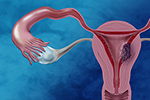Last updated: March 08, 2019
News Features From Dir
Division of Intramural Research News Features
2019
-
NHGRI researchers map the brain to find links between genes and ADHD
 When it comes to Attention-Deficit/Hyperactivity Disorder (ADHD), genetics do make an impact, but it is not easily pinned down. Many common but subtle differences in our DNA come together to have a huge influence on creating one of ADHD's cardinal symptoms: hyperactivity-impulsivity. In a study published in the January 30 issue of Molecular Psychiatry, NHGRI researchers examined people with ADHD to map brain connections, called white matter tracts, tied to the disorder.
When it comes to Attention-Deficit/Hyperactivity Disorder (ADHD), genetics do make an impact, but it is not easily pinned down. Many common but subtle differences in our DNA come together to have a huge influence on creating one of ADHD's cardinal symptoms: hyperactivity-impulsivity. In a study published in the January 30 issue of Molecular Psychiatry, NHGRI researchers examined people with ADHD to map brain connections, called white matter tracts, tied to the disorder. -
Pregnant women want physicians' advice on receiving fetal genomic information
 Most pregnant women want doctors' advice on the types of information to receive from prenatal whole genome sequencing. Obstetricians and other clinicians will need additional training on how to present fetal genomic information in a way that meets an individual woman's needs.
Most pregnant women want doctors' advice on the types of information to receive from prenatal whole genome sequencing. Obstetricians and other clinicians will need additional training on how to present fetal genomic information in a way that meets an individual woman's needs. -
Cancer drug reduces pain, improves symptoms in people with Proteus syndrome
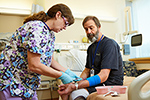 Researchers with the National Institutes of Health Undiagnosed Disease Program have developed a powerful new toolset for finding potential disease-causing gene variants in undiagnosed patients. The work is automatically accomplished by computers - with no human interpretation or bias - and takes about three hours per exome, an individual's protein-coding genes.
Researchers with the National Institutes of Health Undiagnosed Disease Program have developed a powerful new toolset for finding potential disease-causing gene variants in undiagnosed patients. The work is automatically accomplished by computers - with no human interpretation or bias - and takes about three hours per exome, an individual's protein-coding genes. -
NIH's new automated toolset detects disease-causing genes in undiagnosed patients
 Researchers with the National Institutes of Health Undiagnosed Disease Program have developed a powerful new toolset for finding potential disease-causing gene variants in undiagnosed patients. The work is automatically accomplished by computers - with no human interpretation or bias - and takes about three hours per exome, an individual's protein-coding genes.
Researchers with the National Institutes of Health Undiagnosed Disease Program have developed a powerful new toolset for finding potential disease-causing gene variants in undiagnosed patients. The work is automatically accomplished by computers - with no human interpretation or bias - and takes about three hours per exome, an individual's protein-coding genes.
2018
-
Sickle cell disease (SCD) community is hopeful that genome editing will rechart course of the disease
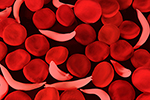 In the first study of its kind, NHGRI researchers explored patients', parents' and physicians' perspectives on the use of CRISPR-Cas9 gene-editing to reverse sickle cell disease. Study participants expressed overall optimism about participating in human genome editing clinical trials, but were concerned about treatment risks and transparency of the research enterprise, according to the findings published December 24 in Genetics in Medicine.
In the first study of its kind, NHGRI researchers explored patients', parents' and physicians' perspectives on the use of CRISPR-Cas9 gene-editing to reverse sickle cell disease. Study participants expressed overall optimism about participating in human genome editing clinical trials, but were concerned about treatment risks and transparency of the research enterprise, according to the findings published December 24 in Genetics in Medicine. -
Elevated hormone flags liver problems in mice with methylmalonic acidemia
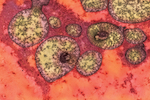 NHGRI researchers have discovered a hormone in a mouse study that can be used immediately to can help doctors predict how severely patients with the rare disease methylmalonic acidemia are affected and when to refer them for liver transplants. The findings, published December 6 in JCI Insight, also might shed light on more common disorders such as fatty liver disease, obesity and diabetes.
NHGRI researchers have discovered a hormone in a mouse study that can be used immediately to can help doctors predict how severely patients with the rare disease methylmalonic acidemia are affected and when to refer them for liver transplants. The findings, published December 6 in JCI Insight, also might shed light on more common disorders such as fatty liver disease, obesity and diabetes. -
NHGRI's Dr. Andy Baxevanis named Fellow of the American Association for the Advancement of Science
 Andy Baxevanis, Ph.D., a senior scientist leading the Computational Genomics Unit at the National Human Genome Research Institute (NHGRI), has been named a Fellow of the American Association for the Advancement of Science (AAAS). Dr. Baxevanis was recognized for his distinguished contributions to the field of comparative genomics, particularly for using computational approaches to study the molecular innovations driving diversity in early animal evolution.
Andy Baxevanis, Ph.D., a senior scientist leading the Computational Genomics Unit at the National Human Genome Research Institute (NHGRI), has been named a Fellow of the American Association for the Advancement of Science (AAAS). Dr. Baxevanis was recognized for his distinguished contributions to the field of comparative genomics, particularly for using computational approaches to study the molecular innovations driving diversity in early animal evolution. -
NHGRI joins international team to sequence Mongolian genomes
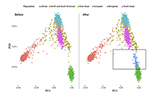 North Asians, including Mongolians and other Siberian ethnic groups, may be more closely related to Eastern and Northern Europeans - including the people of Finland -- than previously thought, according to a new genomics study in Nature Genetics. The international team of researchers, including those from the National Human Genome Research Institute (NHGRI), made the connection by comparing the whole-genome sequences of 175 ethnic Mongolians to existing genetic variation data.
North Asians, including Mongolians and other Siberian ethnic groups, may be more closely related to Eastern and Northern Europeans - including the people of Finland -- than previously thought, according to a new genomics study in Nature Genetics. The international team of researchers, including those from the National Human Genome Research Institute (NHGRI), made the connection by comparing the whole-genome sequences of 175 ethnic Mongolians to existing genetic variation data. -
Systematic review study supports that sickle cell trait increases risk for some health conditions
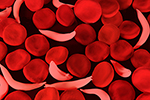 In the United States, an estimated 2.5 to 3 million people have a gene variant associated sickle cell trait (SCT) and most never have related health complications. NIH researchers and their colleagues have now identified three health conditions for which people with SCT are at increased risk. They include pulmonary embolism, proteinuria and chronic kidney disease. Findings from this first comprehensive review of clinical outcomes associated with SCT were published in the October 30, 2018, issue of the Annals of Internal Medicine.
In the United States, an estimated 2.5 to 3 million people have a gene variant associated sickle cell trait (SCT) and most never have related health complications. NIH researchers and their colleagues have now identified three health conditions for which people with SCT are at increased risk. They include pulmonary embolism, proteinuria and chronic kidney disease. Findings from this first comprehensive review of clinical outcomes associated with SCT were published in the October 30, 2018, issue of the Annals of Internal Medicine. -
New technique promising for a more accurate genome sequence
 Researchers at the National Institutes of Health (NIH) and the United States Department of Agriculture (USDA) have developed a new technique that will aid in a more accurate reconstruction of genomes, specifically in determining the sections of the genome that come from each parent. This new technique, published in the journal Nature Biotechnology, will allow researchers to identify further complexity within any type of genome - from plants to humans - and provide more precise reference genomes in researcher databases than are currently available.
Researchers at the National Institutes of Health (NIH) and the United States Department of Agriculture (USDA) have developed a new technique that will aid in a more accurate reconstruction of genomes, specifically in determining the sections of the genome that come from each parent. This new technique, published in the journal Nature Biotechnology, will allow researchers to identify further complexity within any type of genome - from plants to humans - and provide more precise reference genomes in researcher databases than are currently available. -
NHGRI Scientific Director Dan Kastner Named 2018 Federal Employee of the Year
 Daniel Kastner, M.D., Ph.D., scientific director of the National Human Genome Research Institute (NHGRI), was named the Federal Employee of the Year as part of the 2018 Samuel J. Heyman Service to America Medals program, known as the "Sammies." Dr. Kasnter is recognized for his work in identifying an entire new class of rare genetic diseases and treatments to alleviate suffering for thousands of patients in the U.S. and around the world.
Daniel Kastner, M.D., Ph.D., scientific director of the National Human Genome Research Institute (NHGRI), was named the Federal Employee of the Year as part of the 2018 Samuel J. Heyman Service to America Medals program, known as the "Sammies." Dr. Kasnter is recognized for his work in identifying an entire new class of rare genetic diseases and treatments to alleviate suffering for thousands of patients in the U.S. and around the world. -
NIH leaders call for a consensus on the use of race and ethnicity data in biomedical research
 The use of racial and ethnic categories in biomedical research is part of a complex and sometimes contentious conversation about how science and society talk about human variation. In a commentary published September 24 in the Journal of the American Medical Association, NIH leaders have called on the scientific community to develop and adopt consensus practices for the use of race, ethnicity, social determinants of health, and ancestry data in study design, interpretation of results, publications and medical care.
The use of racial and ethnic categories in biomedical research is part of a complex and sometimes contentious conversation about how science and society talk about human variation. In a commentary published September 24 in the Journal of the American Medical Association, NIH leaders have called on the scientific community to develop and adopt consensus practices for the use of race, ethnicity, social determinants of health, and ancestry data in study design, interpretation of results, publications and medical care. -
NHGRI's Stacy Desine first post bac to win 2018 TmT competition
 Every year, graduate students and postdocs at the National Human Genome Research Institute (NHGRI) and other institutes at the National Institutes of Health compete in a high-energy science communications contest called the Three-Minute Talk (TmT). For the first time in competition history, all the participating institutes agreed to allow postbacs to compete in the TmT finals. NHGRI's Stacy Desine earned first place after the finals on June 29, 2018, becoming the first postbac to win the TmT competition.
Every year, graduate students and postdocs at the National Human Genome Research Institute (NHGRI) and other institutes at the National Institutes of Health compete in a high-energy science communications contest called the Three-Minute Talk (TmT). For the first time in competition history, all the participating institutes agreed to allow postbacs to compete in the TmT finals. NHGRI's Stacy Desine earned first place after the finals on June 29, 2018, becoming the first postbac to win the TmT competition. -
NIH researchers identify genes associated with super-athletic sport hunting dogs
 In the world of canine genomics, sport hunting dogs are super athletes and terriers are plucky supermodels. NHGRI researchers reached this conclusion after identifying 59 genes or gene regions linked to canine athletics, including those with roles in endurance, heart function, blood flow and pain perception. What terriers lacked in sporty genes, they made up for in genes associated with physical attributes such as their trademark facial hair. The researchers published their findings in The Proceedings of the National Academy of Science (PNAS).
In the world of canine genomics, sport hunting dogs are super athletes and terriers are plucky supermodels. NHGRI researchers reached this conclusion after identifying 59 genes or gene regions linked to canine athletics, including those with roles in endurance, heart function, blood flow and pain perception. What terriers lacked in sporty genes, they made up for in genes associated with physical attributes such as their trademark facial hair. The researchers published their findings in The Proceedings of the National Academy of Science (PNAS). -
One patient's diagnostic odyssey ends at the NIH Clinical Center
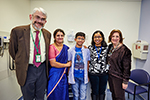 A year ago 14-year-old Rohith Lokesh spent most of his days barely walking and in a wheelchair. After cutting-edge treatment at the NIH Clinical Center this patient is winning dance contests back in his hometown. This patient's story highlights what the NIH Clinical Center can do that's hard to do somewhere else. From using mechanistic studies and genome sequencing to inform your patient care - that's unique to NIH.
A year ago 14-year-old Rohith Lokesh spent most of his days barely walking and in a wheelchair. After cutting-edge treatment at the NIH Clinical Center this patient is winning dance contests back in his hometown. This patient's story highlights what the NIH Clinical Center can do that's hard to do somewhere else. From using mechanistic studies and genome sequencing to inform your patient care - that's unique to NIH. -
Genomic databases weakened by lack of non-European populations
 Precision medicine will largely be built on vast troves of genomic information, but diverse populations are still underrepresented in public genomic databases, according to a new study by researchers from Partners Healthcare/Harvard Medical School and the National Institutes of Health. They found significantly fewer studies of African, Latin American and Asian ancestral populations compared to European populations in two public databases. Findings were published online May 7 in Health Affairs.
Precision medicine will largely be built on vast troves of genomic information, but diverse populations are still underrepresented in public genomic databases, according to a new study by researchers from Partners Healthcare/Harvard Medical School and the National Institutes of Health. They found significantly fewer studies of African, Latin American and Asian ancestral populations compared to European populations in two public databases. Findings were published online May 7 in Health Affairs. -
NIH researchers link graying hair and the immune system
 Researchers at the National Institutes of Health and the University of Alabama have discovered a connection between the genes that contribute to hair color and the genes that control the body's immune system. This new mouse study offers insights into why some people's hair goes gray in response to a serious illness or chronic stress.They published their findings May 3, 2018, in PLOS Biology.
Researchers at the National Institutes of Health and the University of Alabama have discovered a connection between the genes that contribute to hair color and the genes that control the body's immune system. This new mouse study offers insights into why some people's hair goes gray in response to a serious illness or chronic stress.They published their findings May 3, 2018, in PLOS Biology. -
Williams-Beurin syndrome added to Atlas of Human Malformation Syndromes in Diverse Populations
 NHGRI researchers and their international collaborators have added Williams-Beuren syndrome to the Atlas of Human Malformation Syndromes in Diverse Populations. By adding highly accurate images and clinical information of diverse people with Williams-Beuren Syndrome, healthcare providers will better recognize and diagnose the rare disease in non-Europeans and deliver critical, early interventions and better medical care. Results are published in the May 2018 issue of the American Journal of Human Genetics
NHGRI researchers and their international collaborators have added Williams-Beuren syndrome to the Atlas of Human Malformation Syndromes in Diverse Populations. By adding highly accurate images and clinical information of diverse people with Williams-Beuren Syndrome, healthcare providers will better recognize and diagnose the rare disease in non-Europeans and deliver critical, early interventions and better medical care. Results are published in the May 2018 issue of the American Journal of Human Genetics -
Researchers study mothers' food choices at virtual reality buffet
 Many Americans love all-you-can-eat buffets - but how do they choose what to eat? Using a virtual reality (VR) buffet, NHGRI researchers studied the hundreds of micro-decisions mothers make while selecting food for their children to better understand the mechanism through which some made healthier choices. Eventually, researchers may be able to design better interventions to improve people's food choice behavior and "nudge" people toward more healthy choices.
Many Americans love all-you-can-eat buffets - but how do they choose what to eat? Using a virtual reality (VR) buffet, NHGRI researchers studied the hundreds of micro-decisions mothers make while selecting food for their children to better understand the mechanism through which some made healthier choices. Eventually, researchers may be able to design better interventions to improve people's food choice behavior and "nudge" people toward more healthy choices.
2017
-
Mouse model for rare genetic disease advances understanding of Parkinson's
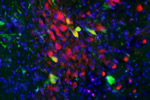 NHGRI researchers and their collaborators are making inroads into the puzzling link between a common disorder, Parkinson's disease, and a rare disorder, Gaucher disease, by cross-breeding mice to carry human mutations causing each of the two diseases. They published their findings in the December 2017 issue of >Molecular Genetics and Metabolism
NHGRI researchers and their collaborators are making inroads into the puzzling link between a common disorder, Parkinson's disease, and a rare disorder, Gaucher disease, by cross-breeding mice to carry human mutations causing each of the two diseases. They published their findings in the December 2017 issue of >Molecular Genetics and Metabolism -
Reddit "Ask Me Anything" Recap: The importance of knowing your family health history
 On November 21, 2017, experts from NHGRI's Social and Behavioral Research Branch (SBRB) turned to a Reddit "Ask Me Anything" (AMA) to answer questions about their work on family health history. AMA hosts were Laura Koehly, Ph.D., SBRB chief, Chris Marcum, Ph.D., a staff scientist, and Jielu Lin, Ph.D., a post-doctoral fellow. The team answered questions from how to change behaviors after learning disease risk through family health history, to understanding risk when family health history is unknown. Here, we recap the event.
On November 21, 2017, experts from NHGRI's Social and Behavioral Research Branch (SBRB) turned to a Reddit "Ask Me Anything" (AMA) to answer questions about their work on family health history. AMA hosts were Laura Koehly, Ph.D., SBRB chief, Chris Marcum, Ph.D., a staff scientist, and Jielu Lin, Ph.D., a post-doctoral fellow. The team answered questions from how to change behaviors after learning disease risk through family health history, to understanding risk when family health history is unknown. Here, we recap the event. -
Dr. Leslie Biesecker selected as 2019 president of ASHG
 American Society of Human Genetics (ASHG) members have selected Leslie G. Biesecker, M.D., a clinical and molecular geneticist and long-time investigator with NHGRI, as their new president-elect. In 2019, Dr. Biesecker will become president of ASHG, a professional membership organization for human genetics specialists worldwide. He will serve in his personal capacity. Dr. Biesecker is the senior investigator and chief of NHGRI's Medical Genomics and Metabolic Genetics Branch.
American Society of Human Genetics (ASHG) members have selected Leslie G. Biesecker, M.D., a clinical and molecular geneticist and long-time investigator with NHGRI, as their new president-elect. In 2019, Dr. Biesecker will become president of ASHG, a professional membership organization for human genetics specialists worldwide. He will serve in his personal capacity. Dr. Biesecker is the senior investigator and chief of NHGRI's Medical Genomics and Metabolic Genetics Branch. -
Reddit "Ask Me Anything" Recap: The Dog Genome Project
 On November 2, 2017, experts from The NHGRI Dog Genome Project turned to Reddit - a social news website and discussion forum - to answer questions from the Reddit community as part of an "Ask Me Anything" (AMA). Dog genomes hold a wealth of information for understanding natural variation in dog populations, like body size or fur type, and for learning more about how the genomes of both dogs and humans contribute to health and disease. Read a recap of the recap of the event.
On November 2, 2017, experts from The NHGRI Dog Genome Project turned to Reddit - a social news website and discussion forum - to answer questions from the Reddit community as part of an "Ask Me Anything" (AMA). Dog genomes hold a wealth of information for understanding natural variation in dog populations, like body size or fur type, and for learning more about how the genomes of both dogs and humans contribute to health and disease. Read a recap of the recap of the event. -
Adult ADHD: An imbalance between the online and offline brain
 A new NHGRI study focused on why some people grow out of childhood attention deficit hyperactivity disorder (ADHD) and others continue to have symptoms into adulthood. They discovered that adults with ADHD persisting from childhood partly lose the usual balance found between brain systems that control action and those that emerge when they are simply day-dreaming or introspecting. This imbalance might account for the lapses of attention that are found in ADHD. The study was published in the Oct. 31 issue of PNAS.
A new NHGRI study focused on why some people grow out of childhood attention deficit hyperactivity disorder (ADHD) and others continue to have symptoms into adulthood. They discovered that adults with ADHD persisting from childhood partly lose the usual balance found between brain systems that control action and those that emerge when they are simply day-dreaming or introspecting. This imbalance might account for the lapses of attention that are found in ADHD. The study was published in the Oct. 31 issue of PNAS. -
NHGRI researchers and collaborators identify Noonan syndrome in diverse people
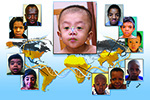 Using facial analysis software, researchers with the National Human Genome Research Institute (NHGRI) and their collaborators successfully diagnosed Noonan syndrome in Africans, Asians and Latin Americans. Noonan syndrome will become part of the Atlas of Human Malformation Syndromes in Diverse Populations, a free online tool that helps healthcare providers better recognize and diagnose rare diseases in non-Europeans. The findings were announced in the September 2017 issue of the American Journal of Medical Genetics.
Using facial analysis software, researchers with the National Human Genome Research Institute (NHGRI) and their collaborators successfully diagnosed Noonan syndrome in Africans, Asians and Latin Americans. Noonan syndrome will become part of the Atlas of Human Malformation Syndromes in Diverse Populations, a free online tool that helps healthcare providers better recognize and diagnose rare diseases in non-Europeans. The findings were announced in the September 2017 issue of the American Journal of Medical Genetics. -
Summer interns help expand a critical resource for diagnosing patients
 Three students from this year's NIH Summer Internship Program in Biomedical Sciences share their experience spending the summer working on The Atlas of Human Malformation Syndromes in Diverse Populations, an online resource that helps healthcare providers diagnose patients from geographically diverse regions of the world. Thousands of applicants compete for spots in the program, which places interns at NHGRI and other institutes to conduct basic and clinical research.
Three students from this year's NIH Summer Internship Program in Biomedical Sciences share their experience spending the summer working on The Atlas of Human Malformation Syndromes in Diverse Populations, an online resource that helps healthcare providers diagnose patients from geographically diverse regions of the world. Thousands of applicants compete for spots in the program, which places interns at NHGRI and other institutes to conduct basic and clinical research. -
NHGRI's Ryan Johnson first place winner in 2017 TmT competition
 The National Human Genome Research Institute (NHGRI) and other institutes at the National Institutes of Health recently participated in a high-energy science communications contest called the Three-Minute Talk (TmT). NHGRI's Ryan Johnson came away with a first place win after the finals on June 29, 2017.
The National Human Genome Research Institute (NHGRI) and other institutes at the National Institutes of Health recently participated in a high-energy science communications contest called the Three-Minute Talk (TmT). NHGRI's Ryan Johnson came away with a first place win after the finals on June 29, 2017. -
Social interaction affects cancer patients' response to treatment
 Cancer patients were a little more likely to survive for five years or more after chemotherapy if they interacted during chemotherapy with other patients who also survived for five years or more, according to a new study by researchers at the National Human Genome Research Institute, part of the National Institutes of Health, and the University of Oxford in the United Kingdom. The findings were published online July 12, 2017, in the journal Network Science
Cancer patients were a little more likely to survive for five years or more after chemotherapy if they interacted during chemotherapy with other patients who also survived for five years or more, according to a new study by researchers at the National Human Genome Research Institute, part of the National Institutes of Health, and the University of Oxford in the United Kingdom. The findings were published online July 12, 2017, in the journal Network Science -
NHGRI study highlights role of mitochondria in immune response
A new study highlights how genomic mutations that cause mitochondrial disease may also compromise affected people's immune response. Based on clinical data from patients with mitochondrial disease, the researchers created a mouse model of mitochondrial disease in T-cells, which play important roles in humans' immune response. The mutations resulted in an increased risk of infections and reduced protective immunity after vaccinations. The study appeared June 6, 2017, in the journal Cell Metabolism.
-
Community focus is central to American Indians/Alaska Natives in NIH ethics training
 Since 2014, NIH has offered Institutional Review Board (IRB) training to American Indians and Alaska Natives. Dr. Deana Around Him, a citizen of Cherokee Nation of Oklahoma and training participant, learned how NIH ensures the welfare of people who participate in biomedical studies and helped improve the IRB training.
Since 2014, NIH has offered Institutional Review Board (IRB) training to American Indians and Alaska Natives. Dr. Deana Around Him, a citizen of Cherokee Nation of Oklahoma and training participant, learned how NIH ensures the welfare of people who participate in biomedical studies and helped improve the IRB training.
-
Dr. Laura Koehly to lead the Social and Behavioral Research Branch at NHGRI
 Laura Koehly, Ph.D., has been named chief of NHGRI's Social and Behavioral Research Branch (SBRB), which conducts research that will potentially transform healthcare through the integration of genomic medicine into the clinic. Her overarching goal for the branch is to build bridges across disciplines, including fields within the social and behavioral sciences and the biological and genomic sciences. SBRB research also includes a focus on disorders that have a major public health impact.
Laura Koehly, Ph.D., has been named chief of NHGRI's Social and Behavioral Research Branch (SBRB), which conducts research that will potentially transform healthcare through the integration of genomic medicine into the clinic. Her overarching goal for the branch is to build bridges across disciplines, including fields within the social and behavioral sciences and the biological and genomic sciences. SBRB research also includes a focus on disorders that have a major public health impact. -
NHGRI researchers home in on mutation profiles of clear cell endometrial cancer
NHGRI researchers and their collaborators have identified mutations in the TAF1 gene in clear cell endometrial cancer (CCEC) tumors, shedding light on the underlying genomic changes that are likely to be important in driving development of this a rare but clinically aggressive form of endometrial cancer. The study was published May 9, 2017, in the journal Cancer.
-
Researchers begin to understand ADHD genes with help from affected families
 Attention-deficit/hyperactivity disorder (ADHD) is highly heritable, but researchers don't know much about the genes that cause it. Read about the experience of a participant in a National Institutes of Health (NIH) clinical trial who is helping researchers find the contributing genes. After researchers at the National Human Genome Research Institute identify the genes, they can begin to look for new medications, new behavioral interventions or new combinations of both.
Attention-deficit/hyperactivity disorder (ADHD) is highly heritable, but researchers don't know much about the genes that cause it. Read about the experience of a participant in a National Institutes of Health (NIH) clinical trial who is helping researchers find the contributing genes. After researchers at the National Human Genome Research Institute identify the genes, they can begin to look for new medications, new behavioral interventions or new combinations of both.
-
Dr. William Gahl inspires collaboration, sharing at Pruzansky lecture
 Dr. William Gahl, clinical director at the National Human Genome Research Institute (NHGRI), gave the honorary Samuel Pruzansky Memorial Lecture on March 23 in Phoenix for the March of Dimes Clinical Genetics Conference. Although he's given dozens of lectures around the world about helping patients with undiagnosed diseases since establishing the Undiagnosed Diseases Program in 2008, this particular talk was truly inspirational.
Dr. William Gahl, clinical director at the National Human Genome Research Institute (NHGRI), gave the honorary Samuel Pruzansky Memorial Lecture on March 23 in Phoenix for the March of Dimes Clinical Genetics Conference. Although he's given dozens of lectures around the world about helping patients with undiagnosed diseases since establishing the Undiagnosed Diseases Program in 2008, this particular talk was truly inspirational. -
Genes associated with Erdheim-Chester disease also linked to cancer
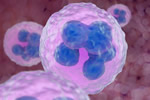 Newly identified genes associated with Erdheim-Chester disease (ECD), an ultra-rare disease, are also linked to cancer, according to a new study by NHGRI researchers. Thus, ECD should be considered a type of cancer and treated by oncologists. A new clinical trial - enrolling ECD patients now - will test the use of the drugs dabrafenib and trametinib. Findings were published in Blood Advances.
Newly identified genes associated with Erdheim-Chester disease (ECD), an ultra-rare disease, are also linked to cancer, according to a new study by NHGRI researchers. Thus, ECD should be considered a type of cancer and treated by oncologists. A new clinical trial - enrolling ECD patients now - will test the use of the drugs dabrafenib and trametinib. Findings were published in Blood Advances. -
Facial recognition software helps diagnose rare genetic disease
 Researchers with NHGRI and their collaborators have successfully used facial recognition software to diagnose DiGeorge Syndrome, a rare, genetic disease in Africans, Asians and Latin Americans. This is the newest addition to the Atlas of Human Malformations in Diverse Populations launched last year. The study was published March 23, 2017, in the American Journal of Medical Genetics.
Researchers with NHGRI and their collaborators have successfully used facial recognition software to diagnose DiGeorge Syndrome, a rare, genetic disease in Africans, Asians and Latin Americans. This is the newest addition to the Atlas of Human Malformations in Diverse Populations launched last year. The study was published March 23, 2017, in the American Journal of Medical Genetics. -
The UDN joins forces with Reddit for an "AMA"
 On March 3, 2017, in honor of Rare Disease Day, experts from the Undiagnosed Diseases Network (UDN) turned to Reddit to answer questions from the Reddit community as part of an "Ask Me Anything" (AMA). These rare disease clinical and research experts have joined forces to solve the world's most challenging medical mysteries. Supported by the NIH Common Fund, UDN uses genome sequencing in the clinic, along with a network of experts, to provide answers for patients and families affected by mysterious conditions. Here's a recap of the event.
On March 3, 2017, in honor of Rare Disease Day, experts from the Undiagnosed Diseases Network (UDN) turned to Reddit to answer questions from the Reddit community as part of an "Ask Me Anything" (AMA). These rare disease clinical and research experts have joined forces to solve the world's most challenging medical mysteries. Supported by the NIH Common Fund, UDN uses genome sequencing in the clinic, along with a network of experts, to provide answers for patients and families affected by mysterious conditions. Here's a recap of the event. -
NIH and USDA scientists publish goat genome sequence
 NIH and USDA researchers have developed a new technique for reconstructing highly accurate reference genomes and have applied it to the domestic goat. Accurate reference genomes are important for understanding an organism's biology, for learning about the genetic causes of health and disease and, in animals, for making breeding decisions. The study is published today, March 6, 2017, in Nature Genetics.
NIH and USDA researchers have developed a new technique for reconstructing highly accurate reference genomes and have applied it to the domestic goat. Accurate reference genomes are important for understanding an organism's biology, for learning about the genetic causes of health and disease and, in animals, for making breeding decisions. The study is published today, March 6, 2017, in Nature Genetics. -
Rare disease research can provide insights into common diseases
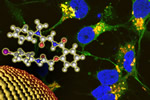 On February 27, several NHGRI researchers - Anastasia L. Wise, Ph.D., Shawn Burgess, Ph.D., and Brian P. Brooks, M.D., Ph.D.- will highlight rare disease research that could benefit affected patients, but also provide insight into more common disorders. They will underline this important relationship in advance of Rare Disease Day at NIH, a day-long symposium that is part of a global effort to raise awareness of rare diseases.
On February 27, several NHGRI researchers - Anastasia L. Wise, Ph.D., Shawn Burgess, Ph.D., and Brian P. Brooks, M.D., Ph.D.- will highlight rare disease research that could benefit affected patients, but also provide insight into more common disorders. They will underline this important relationship in advance of Rare Disease Day at NIH, a day-long symposium that is part of a global effort to raise awareness of rare diseases. -
NIH study reveals how melanoma spreads
 Newly identified genes and genetic pathways in primary melanoma - a type of skin cancer - could give researchers new targets for developing new personalized treatments for melanoma, and potentially other cancers. Learning how the genes are expressed - turned on or off - could be used in the future to predict how and when the cancer cells will spread to other parts of the body and how fast they will grow. Read the study in the February 6, 2017, online issue of Pigment Cell and Melanoma Research
Newly identified genes and genetic pathways in primary melanoma - a type of skin cancer - could give researchers new targets for developing new personalized treatments for melanoma, and potentially other cancers. Learning how the genes are expressed - turned on or off - could be used in the future to predict how and when the cancer cells will spread to other parts of the body and how fast they will grow. Read the study in the February 6, 2017, online issue of Pigment Cell and Melanoma Research -
Findings: Induced pluripotent stem cells don't increase genetic mutations
 Despite immense promise, adoption of induced pluripotent stem cells (iPSCs) in biomedical research and medicine has been slowed by concerns that these cells are prone to increased numbers of genetic mutations. A new study by NHGRI scientists suggests that iPSCs do not develop more mutations than cells that are duplicated by subcloning. Read the study in The Proceedings of the National Academy of Sciences. early edition for February 6, 2017.
Despite immense promise, adoption of induced pluripotent stem cells (iPSCs) in biomedical research and medicine has been slowed by concerns that these cells are prone to increased numbers of genetic mutations. A new study by NHGRI scientists suggests that iPSCs do not develop more mutations than cells that are duplicated by subcloning. Read the study in The Proceedings of the National Academy of Sciences. early edition for February 6, 2017. -
Research provides more insight into genetic basis of Behçet's disease
 Behçet's disease is a disease that destroys blood vessels through systemic inflammation, manifesting as painful oral and genital ulcers, as well as vision destroying inflammation of the eyes. Research suggests the disease develops due to pathogen exposure, along with a mix of genetic and environmental risk factors, but their interaction is poorly understood. The study appears in the February 6, 2017 online version of Nature Genetics.
Behçet's disease is a disease that destroys blood vessels through systemic inflammation, manifesting as painful oral and genital ulcers, as well as vision destroying inflammation of the eyes. Research suggests the disease develops due to pathogen exposure, along with a mix of genetic and environmental risk factors, but their interaction is poorly understood. The study appears in the February 6, 2017 online version of Nature Genetics. -
Health disparities research focused on the microbiome requires the collaboration of many disciplines
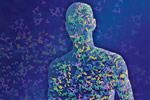 NHGRI researchers and their colleagues are calling for health disparities research that focuses on the microbiome. Health disparities -- the negative health outcomes that impact certain groups of people - and the microbiome - the microorganisms that live in and on us -- are both influenced by people's environments and social interactions. As a result, the microbiome and health differences experienced by diverse people may be a two-way street, with the biological and environmental factors influencing each other, according to the perspective published in the journal Trends in Microbiology.
NHGRI researchers and their colleagues are calling for health disparities research that focuses on the microbiome. Health disparities -- the negative health outcomes that impact certain groups of people - and the microbiome - the microorganisms that live in and on us -- are both influenced by people's environments and social interactions. As a result, the microbiome and health differences experienced by diverse people may be a two-way street, with the biological and environmental factors influencing each other, according to the perspective published in the journal Trends in Microbiology.
2016
-
Physician attitudes will impact adoption of prenatal whole genome sequencing
 Through a simple blood test, physicians will soon be able to map the fetus' entire collection of genes (the whole genome) using fetal DNA that floats in the mother's blood. But a survey of 1,000 physicians says that ethical guidelines must be developed first. Researchers with the National Human Genome Research Institute (NHGRI) published their findings in the December 6th issue of the journal Prenatal Diagnosis.
Through a simple blood test, physicians will soon be able to map the fetus' entire collection of genes (the whole genome) using fetal DNA that floats in the mother's blood. But a survey of 1,000 physicians says that ethical guidelines must be developed first. Researchers with the National Human Genome Research Institute (NHGRI) published their findings in the December 6th issue of the journal Prenatal Diagnosis. -
NIH researchers identify heritable brain connections linked to ADHD
 NHGRI researchers have identified connections in the brain that are linked to Attention Deficit Hyperactivity Disorder (ADHD). Researchers studied large, multi-generational families to detect which brain connections are heritable in ADHD, those passed down from parent to child. These heritable brain features can help researchers discover and understand the genes associated with ADHD. The study was published November 16 in JAMA Psychiatry.
NHGRI researchers have identified connections in the brain that are linked to Attention Deficit Hyperactivity Disorder (ADHD). Researchers studied large, multi-generational families to detect which brain connections are heritable in ADHD, those passed down from parent to child. These heritable brain features can help researchers discover and understand the genes associated with ADHD. The study was published November 16 in JAMA Psychiatry. -
Three students jump-start a career in genomics
 Three students share their stories about being a part of the National Institutes of Health (NIH) Summer Internship Program in Biomedical Sciences. The program, one of four NIH internship subprograms, was launched in 2015 to increase the participation of students from underrepresented backgrounds in science. Non-traditional college students and students from diverse backgrounds are given the opportunity to perform cutting edge research in a federal lab.
Three students share their stories about being a part of the National Institutes of Health (NIH) Summer Internship Program in Biomedical Sciences. The program, one of four NIH internship subprograms, was launched in 2015 to increase the participation of students from underrepresented backgrounds in science. Non-traditional college students and students from diverse backgrounds are given the opportunity to perform cutting edge research in a federal lab. -
Training docs to be researchers, too
 The Physician-Scientist Development Program (PSDP) at the National Human Genome Research Institute helps physicians develop research programs dedicated to the disorders they specialize in. The program trains fellows to use the tools that unlock information in the human genome for real world applications, such as finding cures for genetic diseases. Armed with training from the PSDP, Dr. Peter McGuire joins the Division of Intramural Research as its newest faculty member.
The Physician-Scientist Development Program (PSDP) at the National Human Genome Research Institute helps physicians develop research programs dedicated to the disorders they specialize in. The program trains fellows to use the tools that unlock information in the human genome for real world applications, such as finding cures for genetic diseases. Armed with training from the PSDP, Dr. Peter McGuire joins the Division of Intramural Research as its newest faculty member. -
NHGRI researcher calls for more genomic research of Africans, people of the African diaspora
 Researchers are now identifying genetic mutations that evolved over thousands of years to protect Africans from disease pathogens. NHGRI Researcher Charles Rotimi, Ph.D., calls for comprehensive DNA sampling and genetic characterization of Africans and the people of the African Diaspora in an opinion article published September 17, in the journal Current Opinion in Genetics & Development.
Researchers are now identifying genetic mutations that evolved over thousands of years to protect Africans from disease pathogens. NHGRI Researcher Charles Rotimi, Ph.D., calls for comprehensive DNA sampling and genetic characterization of Africans and the people of the African Diaspora in an opinion article published September 17, in the journal Current Opinion in Genetics & Development. -
Sardinian dog genome reveals a shared ancestral homeland with humans
 The genetic origins of the Sardinian dog (also called Fonni's dogs for the city) mirror recent studies that also traced the genetic origins of human Sardinians to the Middle East and Hungary according to scientists at the National Human Genome Research Institute. Sequencing the whole genome of Fonni's dogs revealed clues about the migration of humans to the area. Findings were reported August 12 in the journal Genetics.
The genetic origins of the Sardinian dog (also called Fonni's dogs for the city) mirror recent studies that also traced the genetic origins of human Sardinians to the Middle East and Hungary according to scientists at the National Human Genome Research Institute. Sequencing the whole genome of Fonni's dogs revealed clues about the migration of humans to the area. Findings were reported August 12 in the journal Genetics. -
One little fish hooks genome researchers with its versatility
 Modern molecular biology and the genome of a tiny silver and black striped fish - the zebrafish - are making waves in genomics research. This tiny fish is a powerhouse tool that helps researchers better understand the genes that are implicated in disease. Here, at the National Human Genome Research Institute (NHGRI), researchers are working to advance human health by coupling the potential of this little fish with an institute-funded resource known as The Zebrafish Core.
Modern molecular biology and the genome of a tiny silver and black striped fish - the zebrafish - are making waves in genomics research. This tiny fish is a powerhouse tool that helps researchers better understand the genes that are implicated in disease. Here, at the National Human Genome Research Institute (NHGRI), researchers are working to advance human health by coupling the potential of this little fish with an institute-funded resource known as The Zebrafish Core. -
New NIH studies seek adults and families affected by sickle cell disease/trait
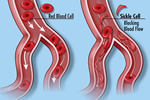 People with sickle cell disease (SCD) can experience excruciating pain all over their bodies, kidney problems, higher risk of stroke and in rare cases, chronic leg ulcers. Little is known about why the severity of these symptoms varies throughout the course of a lifetime, and why these symptoms differ from person to person. Researchers at the National Human Genome Research Institute (NHGRI) are seeking help from people affected by SCD to find the factors - environmental, social and genetic -- that impact the severity of symptoms. They hope to develop guidelines and educational programs aimed at reducing the severity of SCD symptoms.
People with sickle cell disease (SCD) can experience excruciating pain all over their bodies, kidney problems, higher risk of stroke and in rare cases, chronic leg ulcers. Little is known about why the severity of these symptoms varies throughout the course of a lifetime, and why these symptoms differ from person to person. Researchers at the National Human Genome Research Institute (NHGRI) are seeking help from people affected by SCD to find the factors - environmental, social and genetic -- that impact the severity of symptoms. They hope to develop guidelines and educational programs aimed at reducing the severity of SCD symptoms. -
Bacterial toxins make the body go boom
 By outward appearances, plants and animals don't seem to have much in common. When it comes to their immune systems, however, they might be more similar than their exteriors suggest. Researchers at the National Human Genome Research Institute (NHGRI) have discovered an immune mechanism in humans, known as a "guard" mechanism, which was once thought to exist only in plants. They've published their results in the June 6 online journal Nature Immunology.
By outward appearances, plants and animals don't seem to have much in common. When it comes to their immune systems, however, they might be more similar than their exteriors suggest. Researchers at the National Human Genome Research Institute (NHGRI) have discovered an immune mechanism in humans, known as a "guard" mechanism, which was once thought to exist only in plants. They've published their results in the June 6 online journal Nature Immunology. -
Perspective: Precision medicine may move us beyond the use of race in prescribing drugs
 Health care providers have long struggled with considering race when prescribing and dosing medications, an approach that oversimplifies the complex interplay of ancestry, health, disease and drug response. In a May 26 New England Journal of Medicine perspective, Vence L. Bonham, J.D., an investigator with NHGRI's Social and Behavioral Research Branch, and his colleagues, are asking if the precision medicine approach will reduce or eliminate the role that race plays in prescribing drugs and in health care overall.
Health care providers have long struggled with considering race when prescribing and dosing medications, an approach that oversimplifies the complex interplay of ancestry, health, disease and drug response. In a May 26 New England Journal of Medicine perspective, Vence L. Bonham, J.D., an investigator with NHGRI's Social and Behavioral Research Branch, and his colleagues, are asking if the precision medicine approach will reduce or eliminate the role that race plays in prescribing drugs and in health care overall. -
Researchers identify genomic signature in some aggressive prostate tumors
 A key challenge health care providers face in treating prostate cancer is distinguishing aggressive, potentially life-threatening tumors from curable, less aggressive tumors. NHGRI researchers and their collaborators have identified a specific genomic signature of some aggressive prostate tumors, which may help pinpoint specific treatment options. Findings from the study were published April 14 online in The American Journal of Human Genetics.
A key challenge health care providers face in treating prostate cancer is distinguishing aggressive, potentially life-threatening tumors from curable, less aggressive tumors. NHGRI researchers and their collaborators have identified a specific genomic signature of some aggressive prostate tumors, which may help pinpoint specific treatment options. Findings from the study were published April 14 online in The American Journal of Human Genetics. -
Fearfulness changes impact of genomic information in overweight women
 New research suggests that fearful patients who received information about the role of genomics in being overweight viewed the information as threatening and were less likely to take steps to improve their health habits than those in a neutral or angry state. The study, by researchers from the National Institutes of Health (NIH) and NHGRI's Social and Behavioral Research Branch was published in an advanced online issue of the Annals of Behavioral Medicine on February 5, 2016.
New research suggests that fearful patients who received information about the role of genomics in being overweight viewed the information as threatening and were less likely to take steps to improve their health habits than those in a neutral or angry state. The study, by researchers from the National Institutes of Health (NIH) and NHGRI's Social and Behavioral Research Branch was published in an advanced online issue of the Annals of Behavioral Medicine on February 5, 2016.
2015
-
T-cell transcription factor may offer new pathway for vaccine research
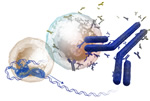 The gold standard for a successful vaccine is the creation of long-lasting antibodies that will defend the body against disease for years. Now, a team headed by scientists at the National Human Genome Research Institute (NHGRI) has found a promising new area for vaccine developers to explore in search of that gold. The new discovery involves a protein called a transcription factor - a molecular switch that turns a gene or a cascade of genes on or off. Read more
The gold standard for a successful vaccine is the creation of long-lasting antibodies that will defend the body against disease for years. Now, a team headed by scientists at the National Human Genome Research Institute (NHGRI) has found a promising new area for vaccine developers to explore in search of that gold. The new discovery involves a protein called a transcription factor - a molecular switch that turns a gene or a cascade of genes on or off. Read more -
Dr. Bob Blakesley, director of the NISC sequencing group, rides off into the sunset
 Robert Blakesley, Ph.D., director of the sequencing group at the NIH Intramural Sequencing Center (NISC) in Rockville, Maryland, will retire on December 31st after a long, distinguished and singularly productive career in DNA sequencing. Known for his meticulous attention to detail, technical expertise and calm nature, Dr. Blakesley credits most of his success to his NISC team, a "fine group of individuals who work very hard."
Robert Blakesley, Ph.D., director of the sequencing group at the NIH Intramural Sequencing Center (NISC) in Rockville, Maryland, will retire on December 31st after a long, distinguished and singularly productive career in DNA sequencing. Known for his meticulous attention to detail, technical expertise and calm nature, Dr. Blakesley credits most of his success to his NISC team, a "fine group of individuals who work very hard." -
NHGRI researchers to present talks, posters at ASHG annual meeting
 National Human Genome Research Institute (NHGRI) researchers will present four platform talks and 55 posters to highlight the institute's diverse portfolio at the 65th annual meeting of the American Society of Human Genetics (ASHG). More than 6,500 scientific attendees and 200 exhibitors are expected to attend the October 6-10 meeting, held this year at The Baltimore Convention Center.
National Human Genome Research Institute (NHGRI) researchers will present four platform talks and 55 posters to highlight the institute's diverse portfolio at the 65th annual meeting of the American Society of Human Genetics (ASHG). More than 6,500 scientific attendees and 200 exhibitors are expected to attend the October 6-10 meeting, held this year at The Baltimore Convention Center. -
An ancient tumor in dogs might teach new tricks about cancer in people
 An ancient, sexually transmitted dog cancer has baffled researchers until now. Canine transmissible venereal tumor, CTVT, spreads when cancer cells move from one dog to another during sexual contact. By comparing the genomes of 186 healthy dogs to two of the dog tumor genomes, NHGRI researchers discovered genetic mutations that prevented the dogs' immune systems from detecting and fending off invading cancer cells. Findings were reported in the July 31, 2015 journal, Genome Research.
An ancient, sexually transmitted dog cancer has baffled researchers until now. Canine transmissible venereal tumor, CTVT, spreads when cancer cells move from one dog to another during sexual contact. By comparing the genomes of 186 healthy dogs to two of the dog tumor genomes, NHGRI researchers discovered genetic mutations that prevented the dogs' immune systems from detecting and fending off invading cancer cells. Findings were reported in the July 31, 2015 journal, Genome Research. -
Investigating why cancer comes back
 For a patient with cancer, two of the most important words in the oncologist's lexicon begin with the letter "r": remission and relapse. Why do some patients stay in remission, while others see their cancer return? In recent research published online in July in the journal Leukemia, Paul Liu, M.D., Ph.D., a senior investigator, and Raman Sood, Ph.D., an associate investigator, in the Translational and Functional Genomics Branch at NHGRI, are trying to understand why leukemia patients relapse, and if there are any DNA-level mutations that account for the leukemia coming back.
For a patient with cancer, two of the most important words in the oncologist's lexicon begin with the letter "r": remission and relapse. Why do some patients stay in remission, while others see their cancer return? In recent research published online in July in the journal Leukemia, Paul Liu, M.D., Ph.D., a senior investigator, and Raman Sood, Ph.D., an associate investigator, in the Translational and Functional Genomics Branch at NHGRI, are trying to understand why leukemia patients relapse, and if there are any DNA-level mutations that account for the leukemia coming back. -
Intramural trainees represent NHGRI at 2015 plain language competition
 NHGRI intramural trainees and representatives from other NIH institutes recently participated in a high-energy science communications contest called the Three-minute Talk (TmT). Five NHGRI intramural trainees competed as finalists, taking on the challenge to use plain language and one Powerpoint slide to explain their research in three-minutes or less. Talks by Dr. Gustavo Sudre (right) and Dr. Melissa Harris placed second and third.
NHGRI intramural trainees and representatives from other NIH institutes recently participated in a high-energy science communications contest called the Three-minute Talk (TmT). Five NHGRI intramural trainees competed as finalists, taking on the challenge to use plain language and one Powerpoint slide to explain their research in three-minutes or less. Talks by Dr. Gustavo Sudre (right) and Dr. Melissa Harris placed second and third. -
Genomic knowledge is power in the fight against obesity
 Although many doctors are wary about discussing weight loss with their overweight patients - for fear of alienating the patients or being ignored - two recent research studies from a team led by NHGRI's Susan Persky, Ph.D., suggest that doctor-patient talks about the genomic underpinnings of obesity can pay off.
Although many doctors are wary about discussing weight loss with their overweight patients - for fear of alienating the patients or being ignored - two recent research studies from a team led by NHGRI's Susan Persky, Ph.D., suggest that doctor-patient talks about the genomic underpinnings of obesity can pay off. -
Studying cancer from the inside out: What the epigenetic code can tell doctors about disease
 How tumors differ from each other - either in different organs or within the same organ - can yield useful clues about cancer prognosis and treatment. Ultimately, that knowledge may lead to precision medicine, where a doctor is not just treating a tumor, but tailoring treatment to the patient's specific tumor. A massive new analysis of tumors, published online April 17 in Epigenetics and Chromatin, is leading medicine closer to these goals.
How tumors differ from each other - either in different organs or within the same organ - can yield useful clues about cancer prognosis and treatment. Ultimately, that knowledge may lead to precision medicine, where a doctor is not just treating a tumor, but tailoring treatment to the patient's specific tumor. A massive new analysis of tumors, published online April 17 in Epigenetics and Chromatin, is leading medicine closer to these goals. -
LabGenius: The next step toward a digital laboratory
 The HHS Ignite Accelerator program, inspired by Silicon Valley start-up methods, nurtures innovative ideas that might improve government operations. Now this seed funding and mentorship program could help create a digital "LabGenius" and, according to NIH Director Francis Collins, M.D., Ph.D., "has the potential to streamline our labs ... which could have a big impact."
The HHS Ignite Accelerator program, inspired by Silicon Valley start-up methods, nurtures innovative ideas that might improve government operations. Now this seed funding and mentorship program could help create a digital "LabGenius" and, according to NIH Director Francis Collins, M.D., Ph.D., "has the potential to streamline our labs ... which could have a big impact." -
Zebrafish a weapon against metastaic cancer
 For many cancer patients and their doctors, the deadliest enemy is metastasis - the migration of cancer cells from the original tumor to other places in the body. Now, a team of National Institutes of Health (NIH) scientists has proposed a promising new approach for finding ways to impede or halt this deadly process. NHGRI's Dr. Shawn Burgess and his colleagues have published that approach online in Disease Models & Mechanisms.
For many cancer patients and their doctors, the deadliest enemy is metastasis - the migration of cancer cells from the original tumor to other places in the body. Now, a team of National Institutes of Health (NIH) scientists has proposed a promising new approach for finding ways to impede or halt this deadly process. NHGRI's Dr. Shawn Burgess and his colleagues have published that approach online in Disease Models & Mechanisms. -
Dogs may help researchers sniff out new cancer detection and treatment strategies
 Scientists at NIH, Purdue and Tufts University have discovered that a genetic mutation that triggers bladder cancer in dogs is identical to a mutation that is implicated in multiple human cancers. Find their research in the March 12, 2015, advance online issue of Molecular Cancer Research. NHGRI's Heidi Parker, Ph.D., and Elaine Ostrander, Ph.D., chief of NHGRI's Cancer Genetics and Comparative Genomics Branch, contributed to the research.
Scientists at NIH, Purdue and Tufts University have discovered that a genetic mutation that triggers bladder cancer in dogs is identical to a mutation that is implicated in multiple human cancers. Find their research in the March 12, 2015, advance online issue of Molecular Cancer Research. NHGRI's Heidi Parker, Ph.D., and Elaine Ostrander, Ph.D., chief of NHGRI's Cancer Genetics and Comparative Genomics Branch, contributed to the research. -
NHGRI/Smithsonian collaboration to sequence North America's oldest dog relics
 When Smithsonian archeologist Dr. Daniel Stanford attended a talk on canine (dog) genomics by NHGRI's Dr. Elaine Ostrander, he realized the potential of the NMNH collection of ancient dog bones to canine genome research. With new sequencing tools and techniques now available - and the complete sequence of the dog genome - both hope to unlock the secrets of this ancient dog DNA, perhaps the oldest in North America.
When Smithsonian archeologist Dr. Daniel Stanford attended a talk on canine (dog) genomics by NHGRI's Dr. Elaine Ostrander, he realized the potential of the NMNH collection of ancient dog bones to canine genome research. With new sequencing tools and techniques now available - and the complete sequence of the dog genome - both hope to unlock the secrets of this ancient dog DNA, perhaps the oldest in North America.
2014
-
California girl's NIH visit includes happy excursions around the nation's capital
 In mid-December, Kareena Hijjawi and her mother flew to the National Institutes of Health for a series of important clinical consultations with the NIH Undiagnosed Diseases Program (UDP). But before the week was out, Kareena would be flocked by a group of dancing ballerinas, dazzled by the opulence of this year's the White House holiday tour, and even get a chance to pet the Obama family dogs, Sunny and Bo.
In mid-December, Kareena Hijjawi and her mother flew to the National Institutes of Health for a series of important clinical consultations with the NIH Undiagnosed Diseases Program (UDP). But before the week was out, Kareena would be flocked by a group of dancing ballerinas, dazzled by the opulence of this year's the White House holiday tour, and even get a chance to pet the Obama family dogs, Sunny and Bo. -
The skin microbiome: More than skin deep
 Skin microbiota plays an intricate role in the human immune system, directing many immune functions and defending against invading bacterial pathogens. In a review article in the Nov. 21, 2014, issue of Science, Julie Segre, Ph.D., Head of the Microbial Genomics Section at NHGRI, and Yasmine Belkaid, Ph.D., head of the Mucosal Immunology Section at NIAID, review the advantages and downsides, of this intimate partnership.
Skin microbiota plays an intricate role in the human immune system, directing many immune functions and defending against invading bacterial pathogens. In a review article in the Nov. 21, 2014, issue of Science, Julie Segre, Ph.D., Head of the Microbial Genomics Section at NHGRI, and Yasmine Belkaid, Ph.D., head of the Mucosal Immunology Section at NIAID, review the advantages and downsides, of this intimate partnership. -
Baylor College of Medicine, Medical College of Wisconsin to conduct DNA sequencing for Undiagnosed Diseases Network
 The National Institutes of Health (NIH) announced today that Baylor College of Medicine in Houston and the Medical College of Wisconsin in Milwaukee will be providing DNA sequencing for the Undiagnosed Diseases Network (UDN). Each site will receive more than $2.5 million over four-years, pending availability of funds.
The National Institutes of Health (NIH) announced today that Baylor College of Medicine in Houston and the Medical College of Wisconsin in Milwaukee will be providing DNA sequencing for the Undiagnosed Diseases Network (UDN). Each site will receive more than $2.5 million over four-years, pending availability of funds. -
NHGRI study uses social media to recruit
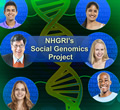 Researchers from NHGRI's Social and Behavioral Research Branch are using the power of social media and mobile phones to study what people around the world think about the intersections between genomics, genetics and society, as a part of the Social Genomics Project. The three-year project is comprised of seven surveys that ask questions about health risks, the flow of health information among family and friends, the use of genomic information to make important life and health decisions, as well as ancestry and race.
Researchers from NHGRI's Social and Behavioral Research Branch are using the power of social media and mobile phones to study what people around the world think about the intersections between genomics, genetics and society, as a part of the Social Genomics Project. The three-year project is comprised of seven surveys that ask questions about health risks, the flow of health information among family and friends, the use of genomic information to make important life and health decisions, as well as ancestry and race. -
CCGO awards exome sequencing to NIH intramural investigators
 Ten intramural investigators will receive exome sequencing data as part of their clinical research projects at the NIH Clinical Center through awards just announced by the National Institutes of Health (NIH) Office of Intramural Research (OIR). The awards are part of a two-year initiative, called the Clinical Center Genomics Opportunity (CCGO), which is encouraging NIH institutes to jumpstart genomic medicine by increasing the use of genomic data in clinical research.
Ten intramural investigators will receive exome sequencing data as part of their clinical research projects at the NIH Clinical Center through awards just announced by the National Institutes of Health (NIH) Office of Intramural Research (OIR). The awards are part of a two-year initiative, called the Clinical Center Genomics Opportunity (CCGO), which is encouraging NIH institutes to jumpstart genomic medicine by increasing the use of genomic data in clinical research. -
NIH researchers use a new cell model of a rare disease to develop therapeutic compounds
 NIH researchers reporting in the June 11, 2014 issue of Science Translational Medicine say they've cleared a major obstacle to testing potential drug therapies for a genetic condition called Gaucher disease. After creating a successful cell model that exhibits the signature traits of the disease, they've now tested a drug compound that has successfully corrected Gaucher's malfunctioning cells.
NIH researchers reporting in the June 11, 2014 issue of Science Translational Medicine say they've cleared a major obstacle to testing potential drug therapies for a genetic condition called Gaucher disease. After creating a successful cell model that exhibits the signature traits of the disease, they've now tested a drug compound that has successfully corrected Gaucher's malfunctioning cells. -
NHGRI's Division of Intramural Research implements new structure
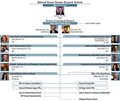 NHGRI Scientific Director Daniel Kastner, M.D., Ph.D., has implemented the reorganization of NHGRI's 45 intramural investigators and associated research programs into a new arrangement of nine branches. The Division of Intramural Research reorganization was announced today at the 71st meeting of the National Advisory Council for Human Genome Research.
NHGRI Scientific Director Daniel Kastner, M.D., Ph.D., has implemented the reorganization of NHGRI's 45 intramural investigators and associated research programs into a new arrangement of nine branches. The Division of Intramural Research reorganization was announced today at the 71st meeting of the National Advisory Council for Human Genome Research. -
NIH program to jump-start genomic medicine
 A new, two-year NIH initiative called the Clinical Center Genomics Opportunity (CCGO) will build an infrastructure for clinical genomic sequencing so clinical researchers can use genomic data for clinical research. CCGO will underwrite the DNA sequencing and analysis of 1,000 exomes, the functionally important 1-2 percent of the genome that codes for proteins.
A new, two-year NIH initiative called the Clinical Center Genomics Opportunity (CCGO) will build an infrastructure for clinical genomic sequencing so clinical researchers can use genomic data for clinical research. CCGO will underwrite the DNA sequencing and analysis of 1,000 exomes, the functionally important 1-2 percent of the genome that codes for proteins. -
NHGRI celebrates the10th anniversary of the Social and Behavioral Research Branch
 Now celebrating its 10th anniversary, NHGRI's Social and Behavioral Research Branch (SBRB) has spent the past few months reflecting on the place of social science research within NHGRI, which is recognized foremost as a bastion of basic research innovation. On January 13, 2014, SBRB will celebrate its 10th anniversary with a celebration featuring guest speakers, posters and interactive exhibits.
Now celebrating its 10th anniversary, NHGRI's Social and Behavioral Research Branch (SBRB) has spent the past few months reflecting on the place of social science research within NHGRI, which is recognized foremost as a bastion of basic research innovation. On January 13, 2014, SBRB will celebrate its 10th anniversary with a celebration featuring guest speakers, posters and interactive exhibits.
2013
-
NHGRI participates in annual American Society of Human Genetics meeting
 The World Series is just one of the passions heating up in Boston this week. The other is the American Society of Human Genetics (ASHG) annual meeting, involving DNA bases rather than those on a baseball diamond. Researchers and staff from NHGRI will be among the 6,500 presenters, exhibitors and attendees for the meeting that runs Oct. 22-26, 2013 at the Boston Convention & Exhibition Center.
The World Series is just one of the passions heating up in Boston this week. The other is the American Society of Human Genetics (ASHG) annual meeting, involving DNA bases rather than those on a baseball diamond. Researchers and staff from NHGRI will be among the 6,500 presenters, exhibitors and attendees for the meeting that runs Oct. 22-26, 2013 at the Boston Convention & Exhibition Center. -
NHGRI and NIH Clinical Center honored with "Sammies"
 This award event feature was delayed due to the government shutdown. On Oct. 3, A team of scientists from NHGRI and the NIH Clinical Center received a Service to America Medal (Sammie) for their efforts to protect patients from infections with drug-resistant bacteria. They demonstrated a new way to trace transmission routes using cutting-edge genomic techniques and state-of-the-art infection control that will help hospitals facing similar crises in the future.
This award event feature was delayed due to the government shutdown. On Oct. 3, A team of scientists from NHGRI and the NIH Clinical Center received a Service to America Medal (Sammie) for their efforts to protect patients from infections with drug-resistant bacteria. They demonstrated a new way to trace transmission routes using cutting-edge genomic techniques and state-of-the-art infection control that will help hospitals facing similar crises in the future. -
NHGRI researchers help identify new metabolic disorder caused by faulty gene expression
 National Human Genome Research Institute (NHGRI) researchers, participating in an international study with colleagues at the University of Colorado in Denver, McGill University in Montreal, Canada, and University Children's Hospital in Zurich, Switzerland have described a new disease involving a defect in the body's ability to process vitamin B12, or cobalamin. The rare inherited disorder that has been only been found in boys, can cause severe neurological symptoms, including developmental delay, epilepsy, and brain malformations.
National Human Genome Research Institute (NHGRI) researchers, participating in an international study with colleagues at the University of Colorado in Denver, McGill University in Montreal, Canada, and University Children's Hospital in Zurich, Switzerland have described a new disease involving a defect in the body's ability to process vitamin B12, or cobalamin. The rare inherited disorder that has been only been found in boys, can cause severe neurological symptoms, including developmental delay, epilepsy, and brain malformations. -
Alyssa's angels: one family's partnership with NIH research
 For 15-year-old Alyssa Meisel, juggling schoolwork, horseback riding, softball and piano is easy. Managing her methylmalonic acidemia (MMA) - a rare metabolic condition that limits her body's ability to metabolize protein - presents a greater challenge that she faces daily with the support of her family and her doctors.
For 15-year-old Alyssa Meisel, juggling schoolwork, horseback riding, softball and piano is easy. Managing her methylmalonic acidemia (MMA) - a rare metabolic condition that limits her body's ability to metabolize protein - presents a greater challenge that she faces daily with the support of her family and her doctors. -
Study suggests the gene variants that cause rare disorder are a risk factor for common form of dementia
 According to a recent study by an international research team that included the National Human Genome Research Institute (NHGRI), people who carry gene alterations that cause Gaucher disease - a rare disease in which a fatty substance (lipid) accumulates in cells and certain organs - also have an elevated risk for Parkinson's disease and dementia with Lewy bodies (DLB), one of the most common types of progressive dementia.
According to a recent study by an international research team that included the National Human Genome Research Institute (NHGRI), people who carry gene alterations that cause Gaucher disease - a rare disease in which a fatty substance (lipid) accumulates in cells and certain organs - also have an elevated risk for Parkinson's disease and dementia with Lewy bodies (DLB), one of the most common types of progressive dementia. -
Study finds regions of the human genome in people of African ancestry associated with BMI
 A large study by a consortium that includes researchers from the National Human Genome Research Institute's Center for Research on Genomics and Global Health has identified genome regions associated with body-mass index (BMI) among people with African ancestry. The study appears in the April 12, 2013 advance online issue of Nature Genetics.
A large study by a consortium that includes researchers from the National Human Genome Research Institute's Center for Research on Genomics and Global Health has identified genome regions associated with body-mass index (BMI) among people with African ancestry. The study appears in the April 12, 2013 advance online issue of Nature Genetics. -
Expanding the limits of modern medicine
 In recognition of Rare Disease Day, read a story of one patient's medical odyssey. Dunham Aurelius became patient 37 in the NIH Undiagnosed Diseases Program. The NIH Common Fund is currently implementing an initiative to expand the work of diagnosing difficult cases like Aurelius' to a network of clinical sites around the country.
In recognition of Rare Disease Day, read a story of one patient's medical odyssey. Dunham Aurelius became patient 37 in the NIH Undiagnosed Diseases Program. The NIH Common Fund is currently implementing an initiative to expand the work of diagnosing difficult cases like Aurelius' to a network of clinical sites around the country. -
NHGRI researchers provide insights on the genetics of dog skull variation
 Breeding has fostered remarkable craniofacial diversity in the domestic dog - from the elongated snouts of Collies to the compressed faces of Pugs. NHGRI researchers review the biology and genetics of canine skull formation in an article appearing in the journal Genetics.
Breeding has fostered remarkable craniofacial diversity in the domestic dog - from the elongated snouts of Collies to the compressed faces of Pugs. NHGRI researchers review the biology and genetics of canine skull formation in an article appearing in the journal Genetics. -
NIH researchers link enzyme deficiency with faulty DNA replication and cancer
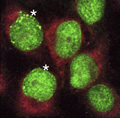 NIH researchers have discovered a cancer-causing flaw that can occur when ATAD5, one of many enzymes in the replication process, is deficient. The defect causes DNA replication to stall and the normal precision of replication proteins to become chaotic. The study appeared in the Dec. 31, 2012, advance online issue of the Journal of Cell Biology.
NIH researchers have discovered a cancer-causing flaw that can occur when ATAD5, one of many enzymes in the replication process, is deficient. The defect causes DNA replication to stall and the normal precision of replication proteins to become chaotic. The study appeared in the Dec. 31, 2012, advance online issue of the Journal of Cell Biology.
2012
-
NHGRI's Intramural Training Office challenges young scientists to imagine their future
 Early career scientists in the National Human Genome Research Institute intramural training program (NHGRI) say that their biggest concern is a challenging job market and what lies ahead for them after their time at NHGRI. To address these worries, NHGRI's Intramural Training Office convened faculty and trainees at the Bolger Center in picturesque Potomac, Maryland, for a one-day meeting.
Early career scientists in the National Human Genome Research Institute intramural training program (NHGRI) say that their biggest concern is a challenging job market and what lies ahead for them after their time at NHGRI. To address these worries, NHGRI's Intramural Training Office convened faculty and trainees at the Bolger Center in picturesque Potomac, Maryland, for a one-day meeting. -
Bioluminescent comb jellies begin to shed light on the evolution of vision
 Bioluminescent sea creatures that emit and detect light are providing clues to the evolution of sight and may, in time, shed light on our understanding of eye diseases. Research published in the December 21 issue of BMC Biology has pinpointed the genes involved in making and sensing light in this organism.
Bioluminescent sea creatures that emit and detect light are providing clues to the evolution of sight and may, in time, shed light on our understanding of eye diseases. Research published in the December 21 issue of BMC Biology has pinpointed the genes involved in making and sensing light in this organism. -
Same gene, different alteration causes another rare, autoinflammatory disease
 NIH researchers have found a second, ultra-rare autoinflammatory disease caused by the same gene that just 10 months ago they attributed to a similar disease discovery. Both diseases cause ultra-rare autoinflammatory conditions, but the involved gene, PLCG2, is altered in different ways and each disease presents distinct symptoms.
NIH researchers have found a second, ultra-rare autoinflammatory disease caused by the same gene that just 10 months ago they attributed to a similar disease discovery. Both diseases cause ultra-rare autoinflammatory conditions, but the involved gene, PLCG2, is altered in different ways and each disease presents distinct symptoms. -
San Francisco hosts 62nd annual meeting of ASHG, Nov. 6-10
 The American Society for Human Genetics (ASHG) convenes in San Francisco Nov. 6-10, 2012, will feature National Human Genome Research Institute research, with presentions on gene discovery in human genetics, progress on gene therapy, cancer genetics, clinical and social implications of genomics and more.
The American Society for Human Genetics (ASHG) convenes in San Francisco Nov. 6-10, 2012, will feature National Human Genome Research Institute research, with presentions on gene discovery in human genetics, progress on gene therapy, cancer genetics, clinical and social implications of genomics and more. -
FDA approves crystal-dissolving eye drops, a major milestone for NIH rare disease researchers
 Read the heroic story about how an experimental eye-drop solution containing a drug called cysteamine eliminates the the painful and destructive crystalline shards in the eyes of patients suffering from a rare, inherited condition called nephropathic cystinosis. Learn how the eyedrop went from clinical trial, to FDA approval and availability for use on Oct. 3, 2012, The research was spearheaded by NHGRI Clinical Director, William Gahl, M.D., Ph.D.
Read the heroic story about how an experimental eye-drop solution containing a drug called cysteamine eliminates the the painful and destructive crystalline shards in the eyes of patients suffering from a rare, inherited condition called nephropathic cystinosis. Learn how the eyedrop went from clinical trial, to FDA approval and availability for use on Oct. 3, 2012, The research was spearheaded by NHGRI Clinical Director, William Gahl, M.D., Ph.D. -
CIDR quenches scientists' thirst for high quality genotyping and sequencing services
 The Center for Inherited Disease Research (CIDR) provides billions of high-quality genotypes and DNA sequences by the gigabase to help investigators identify genes that contribute to human health and disease. CIDR recently celebrated its 15-year anniversary with a $101 million, five-year renewal contract. Learn more about this NHGRI-managed program.
The Center for Inherited Disease Research (CIDR) provides billions of high-quality genotypes and DNA sequences by the gigabase to help investigators identify genes that contribute to human health and disease. CIDR recently celebrated its 15-year anniversary with a $101 million, five-year renewal contract. Learn more about this NHGRI-managed program. -
Genomics in Medicine Lecture Series resumes
 On September 7, NHGRI scientific director and inflammatory disease expert Dan Kastner, M.D., begins the 2012-2013 Genomics in Medicine Lecture Series with Horror Autoinflammaticus: Adventures in the Genomics of Inflammationas. The monthly series, begun in December 2011, aims to enhance how we understand the intersection between genomics and medicine.
On September 7, NHGRI scientific director and inflammatory disease expert Dan Kastner, M.D., begins the 2012-2013 Genomics in Medicine Lecture Series with Horror Autoinflammaticus: Adventures in the Genomics of Inflammationas. The monthly series, begun in December 2011, aims to enhance how we understand the intersection between genomics and medicine. -
Tracking infectious outbreaks by their genomes
 Last year, the NIH Clinical Center dealt with an outbreak of antibiotic resistant klebsiella. Read the full story of how NHGRI and genome sequencing helped discover how the microbe had spread and identified unexpected modes of transmission. The report is published in the August 22, 2012 online edition of Science Translational Medicine.
Last year, the NIH Clinical Center dealt with an outbreak of antibiotic resistant klebsiella. Read the full story of how NHGRI and genome sequencing helped discover how the microbe had spread and identified unexpected modes of transmission. The report is published in the August 22, 2012 online edition of Science Translational Medicine. -
NIH researchers use brain imaging to understand a genetic link between Parkinson's and a rare disease
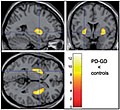 A rare metabolic disorder is helping researchers at the National Human Genome Research Institute (NHGRI) and the National Institute of Mental Health (NIMH) uncover new clues about the biology underlying Parkinson's disease. The results of their six-year study, published online in the July 30, 2012, issue of the journal Brain, may explain how people with alterations in the gene involved in Gaucher disease are more likely to develop Parkinson's - and provide a window to potential inner workings of Parkinson's itself.
A rare metabolic disorder is helping researchers at the National Human Genome Research Institute (NHGRI) and the National Institute of Mental Health (NIMH) uncover new clues about the biology underlying Parkinson's disease. The results of their six-year study, published online in the July 30, 2012, issue of the journal Brain, may explain how people with alterations in the gene involved in Gaucher disease are more likely to develop Parkinson's - and provide a window to potential inner workings of Parkinson's itself. -
NHGRI finds "off" switch that underlies rare genetic disease affecting boys
 A rare, genetic disease found only in boys is helping researchers at the National Human Genome Research Institute (NHGRI) unlock secrets about how the body fends off infection. Studying a mouse model of an inherited disease called X-linked lymphoproliferative syndrome (XLP), they have discovered new details explaining how a missing protein can disrupt communication between two important types of white blood cells, T and B cells, which play key roles in immunity.
A rare, genetic disease found only in boys is helping researchers at the National Human Genome Research Institute (NHGRI) unlock secrets about how the body fends off infection. Studying a mouse model of an inherited disease called X-linked lymphoproliferative syndrome (XLP), they have discovered new details explaining how a missing protein can disrupt communication between two important types of white blood cells, T and B cells, which play key roles in immunity. -
NHGRI researchers find susceptibility mutations in patients with no cancer history
 NHGRI researchers report in the American Journal of Human Genetics that gene variants in a patient's DNA that are classified as incidental or secondary gene variants are medically important. They identified cancer susceptibility mutations in DNA sequence collected as part of an NIH study called ClinSeqtm.
NHGRI researchers report in the American Journal of Human Genetics that gene variants in a patient's DNA that are classified as incidental or secondary gene variants are medically important. They identified cancer susceptibility mutations in DNA sequence collected as part of an NIH study called ClinSeqtm. -
Study delivers new insights about effects of metabolic disorder on cognition and learning
 The baby seems normal at birth, but as he or she starts to eat the vomiting begins. Other symptoms might include dehydration, panting, lethargy, failure to thriveand then it gets really bad: seizures, encephalopathy and stroke. If the disease isn't picked up by a newborn screening test - usually a heel stick that produces a drop of blood for testing up to 40 disorders - terrified parents present their deteriorating baby for answers.
The baby seems normal at birth, but as he or she starts to eat the vomiting begins. Other symptoms might include dehydration, panting, lethargy, failure to thriveand then it gets really bad: seizures, encephalopathy and stroke. If the disease isn't picked up by a newborn screening test - usually a heel stick that produces a drop of blood for testing up to 40 disorders - terrified parents present their deteriorating baby for answers. -
High-throughput screening finds surprising properties for antioxidants
 Antioxidants have long been thought to have anti-aging properties. The story now appears to be much more complicated. A National Institutes of Health research team has demonstrated that some anti-oxidants damage DNA, yet may be good for treating cancer. The findings are published today, March 19th, in the Proceedings of the National Academy of Sciences
Antioxidants have long been thought to have anti-aging properties. The story now appears to be much more complicated. A National Institutes of Health research team has demonstrated that some anti-oxidants damage DNA, yet may be good for treating cancer. The findings are published today, March 19th, in the Proceedings of the National Academy of Sciences -
Bert Vogelstein considers the cancer genome at 10th annual NHGRI Trent Lectureship
 Researchers have published 852 studies describing the genomes of 23 different cancers over the past half century and a number of things have become clear. Though every cancer is different, tumors tend to have a very similar number of gene mutations, Bert Vogelstein, M.D., told a National Institutes of Health (NIH) audience of more than 500 attending the 10th annual Jeffrey M. Trent Lectureship in Cancer Research on Feb. 29, 2012.
Researchers have published 852 studies describing the genomes of 23 different cancers over the past half century and a number of things have become clear. Though every cancer is different, tumors tend to have a very similar number of gene mutations, Bert Vogelstein, M.D., told a National Institutes of Health (NIH) audience of more than 500 attending the 10th annual Jeffrey M. Trent Lectureship in Cancer Research on Feb. 29, 2012. -
Researchers use genomics to differentiate two ovarian cancer subtypes
 Researchers from NHGRI's Genome Technology Branch have distinguished among particular ovarian cancer subtypes based on signals that turn a gene on or off, a process known as DNA methylation. The findings, published in the March 5, 2012, issue of PLoS One, could lead to the precise classification of ovarian cancer tumors and improve treatment strategies.
Researchers from NHGRI's Genome Technology Branch have distinguished among particular ovarian cancer subtypes based on signals that turn a gene on or off, a process known as DNA methylation. The findings, published in the March 5, 2012, issue of PLoS One, could lead to the precise classification of ovarian cancer tumors and improve treatment strategies. -
Rare lethal disorder traced to variant of the PIGA gene on the X chromosome
 Next-generation genomic sequencing - technologies that streamline the processing and analysis of DNA - are well suited to rare disease discovery, as a recent study led by National Human Genome Research Institute (NHGRI) researchers demonstrates.
Next-generation genomic sequencing - technologies that streamline the processing and analysis of DNA - are well suited to rare disease discovery, as a recent study led by National Human Genome Research Institute (NHGRI) researchers demonstrates.
2011
-
NHGRI supports seven young investigators on research career paths
 Four National Human Genome Research Institute postdoctoral fellows and three NHGRI-supported researchers at university laboratories recently received National Institutes of Health (NIH) Pathway to Independence Awards. The prestigious NIH award program helps young investigators make the transition from postdoctoral training to research independence.
Four National Human Genome Research Institute postdoctoral fellows and three NHGRI-supported researchers at university laboratories recently received National Institutes of Health (NIH) Pathway to Independence Awards. The prestigious NIH award program helps young investigators make the transition from postdoctoral training to research independence. -
Next-Gen 101: Video Tutorial on Conducting Whole-Exome Sequencing Research
 On September 28, 2011, the National Human Genome Research Institute offered a daylong course to help researchers use the new and more affordable technique called whole-exome genome sequencing. NHGRI now offers archival video of the presentations for those unable to participate.
On September 28, 2011, the National Human Genome Research Institute offered a daylong course to help researchers use the new and more affordable technique called whole-exome genome sequencing. NHGRI now offers archival video of the presentations for those unable to participate. -
NIH researchers achieve better understanding of skin cancer
 NHGRI's Dr. Yardena Samuels and an NIH-led team studying the genetics of melanoma have found that mutations in the metabotropic glutamate receptor-3 (GRM3) gene cause some cases of melanoma. The study is published in the September. 25, early online issue of Nature Genetics.
NHGRI's Dr. Yardena Samuels and an NIH-led team studying the genetics of melanoma have found that mutations in the metabotropic glutamate receptor-3 (GRM3) gene cause some cases of melanoma. The study is published in the September. 25, early online issue of Nature Genetics. -
William Gahl honored with prestigious Service to America Medal
 On September 15, the Partnership for Public Service, awarded NHGRI's William A. Gahl, M.D., Ph.D., the Science and Environmental Medal, one of nine Samuel J. Heyman Service to America Medals (the "Sammies") the Partnership bestowed at a Washington D.C. gala event. Sammies are awared to outstanding public servants for remarkable work assisting Americans in need, keeping us safe and advancing our national interests.
On September 15, the Partnership for Public Service, awarded NHGRI's William A. Gahl, M.D., Ph.D., the Science and Environmental Medal, one of nine Samuel J. Heyman Service to America Medals (the "Sammies") the Partnership bestowed at a Washington D.C. gala event. Sammies are awared to outstanding public servants for remarkable work assisting Americans in need, keeping us safe and advancing our national interests. -
Dr. Chris Amos cuts through the smoke at NHGRI's Annual Trent Lecture
 On September 7, Christopher I. Amos, Ph.D., professor of epidemiology and biomathematics at the University of Texas M.D. Anderson Cancer Center, took the Masur Auditorium podium on the National Institutes of Health Bethesda campus and described the evolution of our current understanding of the complex genetic and environmental relationship between smoking tobacco and lung cancer risk. His talk was the ninth annual Jeffery M. Trent Lectureship in Cancer Research.
On September 7, Christopher I. Amos, Ph.D., professor of epidemiology and biomathematics at the University of Texas M.D. Anderson Cancer Center, took the Masur Auditorium podium on the National Institutes of Health Bethesda campus and described the evolution of our current understanding of the complex genetic and environmental relationship between smoking tobacco and lung cancer risk. His talk was the ninth annual Jeffery M. Trent Lectureship in Cancer Research. -
NHGRI researchers serve up mysterious disease diagnosis - three ways
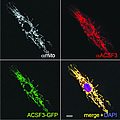 Combined malonic and methylmalonic aciduria, or CMAMMA is a disorder whose unwieldy name refers to the types of chemicals that accumulate in the blood and urine instead of being metabolized or converted to energy as in healthy people. A team led by researchers at the National Human Genome Research Institute has discovered the gene mutation that causes CMAMMA. The study is published in the August 14, 2011 advance online issue of the journal Nature Genetics.
Combined malonic and methylmalonic aciduria, or CMAMMA is a disorder whose unwieldy name refers to the types of chemicals that accumulate in the blood and urine instead of being metabolized or converted to energy as in healthy people. A team led by researchers at the National Human Genome Research Institute has discovered the gene mutation that causes CMAMMA. The study is published in the August 14, 2011 advance online issue of the journal Nature Genetics. -
NHGRI researchers identify gene for inherited bleeding disorder
 An eight-year gene hunt has culminated successfully for National Human Genome Research Institute researchers studying the inherited bleeding disorder gray platelet syndrome (GPS). The researchers found that mutations in the NBEAL2 gene cause GPS. The study was published in the July 17, 2011, early online issue of Nature Genetics.
An eight-year gene hunt has culminated successfully for National Human Genome Research Institute researchers studying the inherited bleeding disorder gray platelet syndrome (GPS). The researchers found that mutations in the NBEAL2 gene cause GPS. The study was published in the July 17, 2011, early online issue of Nature Genetics. -
Paul Liu Named NHGRI Deputy Scientific Director
 P. Paul Liu, M.D., Ph.D., a tenured senior investigator who joined the National Institutes of Health in 1993, has been named deputy scientific director of the National Human Genome Research Institute. He will help provide scientific and administrative leadership in the Institute's Division of Intramural Research.
P. Paul Liu, M.D., Ph.D., a tenured senior investigator who joined the National Institutes of Health in 1993, has been named deputy scientific director of the National Human Genome Research Institute. He will help provide scientific and administrative leadership in the Institute's Division of Intramural Research. -
Researchers identify potential treatment for the lethal premature aging disorder progeria
 Researchers from the National Human Genome Research Institute (NHGRI) at the National Institutes of Health, the University of Maryland and Massachusetts General Hospital have shown that cells from patients with the rare premature aging condition Hutchinson-Gilford progeria respond to treatment with the antibiotic rapamycin. The results of the study could lead to a potential therapy for the lethal genetic condition and advance biological understanding of the normal aging process.
Researchers from the National Human Genome Research Institute (NHGRI) at the National Institutes of Health, the University of Maryland and Massachusetts General Hospital have shown that cells from patients with the rare premature aging condition Hutchinson-Gilford progeria respond to treatment with the antibiotic rapamycin. The results of the study could lead to a potential therapy for the lethal genetic condition and advance biological understanding of the normal aging process. -
May 31, 2011: Researchers identify key to molecular signals in disease affecting Mediterranean populations
 National Institutes of Health researchers studying familial Mediterranean fever (FMF) have discovered a novel pathway triggering inflammation in these patients. These findings provide fundamental insights into the innate immune system, the body's first line of defense against infection, and may improve treatment options for patients with FMF and other inflammatory conditions. The study was released in the May 19, 2011, early online edition of Immunity.
National Institutes of Health researchers studying familial Mediterranean fever (FMF) have discovered a novel pathway triggering inflammation in these patients. These findings provide fundamental insights into the innate immune system, the body's first line of defense against infection, and may improve treatment options for patients with FMF and other inflammatory conditions. The study was released in the May 19, 2011, early online edition of Immunity. -
May 2, 2011: NHGRI Scientific Director Daniel Kastner is inducted into the National Academy of Sciences
 On April 30, NHGRI Scientific Director Daniel Kastner, M.D., Ph.D., was inducted as a member of the National Academy of Sciences (NAS) at a ceremony in Baltimore. NAS is an elite body of approximately 2,100 distinguished U.S. scientists and engineers who advise the federal government on science and technology.
On April 30, NHGRI Scientific Director Daniel Kastner, M.D., Ph.D., was inducted as a member of the National Academy of Sciences (NAS) at a ceremony in Baltimore. NAS is an elite body of approximately 2,100 distinguished U.S. scientists and engineers who advise the federal government on science and technology. -
April 18, 2011: Parents favor genetic tests that might detect children's susceptibility to common diseases
 Parents are generally willing to allow genetic testing to determine their children's susceptibility to eight, adult-onset health conditions, according to new study published in the April 18, online edition of the journal Pediatrics. NHGRI's Social and Behavioral Research Branch Chief Dr. Colleen McBride is the paper's senior author.
Parents are generally willing to allow genetic testing to determine their children's susceptibility to eight, adult-onset health conditions, according to new study published in the April 18, online edition of the journal Pediatrics. NHGRI's Social and Behavioral Research Branch Chief Dr. Colleen McBride is the paper's senior author. -
April 7, 2011: In Mouse Study, NIH Investigators Observe the Immune-Boosting Properties of Vitamin A
 A new study in which National Human Genome Research Institute researchers collaborated with colleagues from the National Institute of Allergy and Infectious Disease helps shed light on how vitamin A regulates the immune system at mucosal surfaces - the moist linings of the mouth, lungs and gastrointestinal track.
A new study in which National Human Genome Research Institute researchers collaborated with colleagues from the National Institute of Allergy and Infectious Disease helps shed light on how vitamin A regulates the immune system at mucosal surfaces - the moist linings of the mouth, lungs and gastrointestinal track. -
April 4, 2011: Symposium ushers in NIH-Lasker Clinical Research Scholars Program
 The dual role of the physician-scientist is part biomedical research and part clinical care. To nurture this training tradition, the National Institutes of Health (NIH) has established the NIH-Lasker Clinical Research Scholars Program. A symposium to kick off the program, featuring talks by four exemplars of the physician-scientist experience, took place March 31 in the Masur Auditorium on NIH's Bethesda campus.
The dual role of the physician-scientist is part biomedical research and part clinical care. To nurture this training tradition, the National Institutes of Health (NIH) has established the NIH-Lasker Clinical Research Scholars Program. A symposium to kick off the program, featuring talks by four exemplars of the physician-scientist experience, took place March 31 in the Masur Auditorium on NIH's Bethesda campus. -
February 21, 2011: NHGRI Researchers Win AAAS Prize for Neanderthal Genome Analysis
 On February 19, two researchers from the National Human Genome Research Institute (NHGRI), along with members of the Neanderthal Genome Analysis Project, won the Newcomb Cleveland Prize from the American Association for the Advancement of Science (AAAS) for the article, A Draft Sequence of the Neandertal Genome.
On February 19, two researchers from the National Human Genome Research Institute (NHGRI), along with members of the Neanderthal Genome Analysis Project, won the Newcomb Cleveland Prize from the American Association for the Advancement of Science (AAAS) for the article, A Draft Sequence of the Neandertal Genome. -
February 14, 2011: NHGRI's William Gahl Honored with Top Governmental Service Award
 On Feb. 9, William A. Gahl, M.D., Ph.D., clinical director of the National Human Genome Research Institute (NHGRI), received the American Medical Association's (AMA) Dr. Nathan Davis Award for Outstanding Government Service for his work establishing the National Institutes of Health Undiagnosed Diseases Program, a trans-NIH initiative that aims to provide diagnoses to patients with mysterious medical conditions. Dr. Gahl accepted the award on behalf of the thousands of patients with rare and undiagnosed disorders.
On Feb. 9, William A. Gahl, M.D., Ph.D., clinical director of the National Human Genome Research Institute (NHGRI), received the American Medical Association's (AMA) Dr. Nathan Davis Award for Outstanding Government Service for his work establishing the National Institutes of Health Undiagnosed Diseases Program, a trans-NIH initiative that aims to provide diagnoses to patients with mysterious medical conditions. Dr. Gahl accepted the award on behalf of the thousands of patients with rare and undiagnosed disorders. -
January 24, 2011: NIH and Wellcome Trust Launch H3Africa.org
 Scientists at African medical research institutions are collaborating with a new initiative called Human Heredity and Health in Africa - or H3Africa - to advance African capacity and expertise in genomic science. H3Africa, announced in June 2010, is organized and supported by the National Institutes of Health (NIH) and the Wellcome Trust, a global charity based in London. Now, H3Africa organizers have launched a new website to serve as a repository for research resources and information about H3Africa.
Scientists at African medical research institutions are collaborating with a new initiative called Human Heredity and Health in Africa - or H3Africa - to advance African capacity and expertise in genomic science. H3Africa, announced in June 2010, is organized and supported by the National Institutes of Health (NIH) and the Wellcome Trust, a global charity based in London. Now, H3Africa organizers have launched a new website to serve as a repository for research resources and information about H3Africa. -
January 10, 2011: Penetrating Spider Bites and Neuropsychiatric Insights
 The female black widow spider is notorious for both her venomous bite and her reputation for using it on her own partner after mating. That venom, containing latrotoxin, places the black widow at the center of a fascinating web - one connecting this neurotoxin to attention deficit hyperactivity disorder (ADHD).
The female black widow spider is notorious for both her venomous bite and her reputation for using it on her own partner after mating. That venom, containing latrotoxin, places the black widow at the center of a fascinating web - one connecting this neurotoxin to attention deficit hyperactivity disorder (ADHD).
2010
-
December 2010: NHGRI Researchers Achieve Successful Gene Therapy in Mice
 Propionic acidemia, a potentially fatal metabolic disorder that affects as many as one in 50,000 American babies, can be treated in mice using gene therapy, according to a National Human Genome Research Institute (NHGRI) study published in the October 2010 advance online issue of Human Gene Therapy.
Propionic acidemia, a potentially fatal metabolic disorder that affects as many as one in 50,000 American babies, can be treated in mice using gene therapy, according to a National Human Genome Research Institute (NHGRI) study published in the October 2010 advance online issue of Human Gene Therapy. -
November 2010: NIH researchers identify genetic cause of anemia disorder
 One of the most common types of familial anemia, hereditary spherocytosis (HS), is caused by a defect in a gene's barrier insulator, a DNA element that keeps a gene's switch in the 'on' position. A team led by researchers at the National Human Genome Research Institute (NHGRI) and Yale University School of Medicine report on their findings in the early online issue of the Nov. 22, 2010, Journal of Clinical Investigation.
One of the most common types of familial anemia, hereditary spherocytosis (HS), is caused by a defect in a gene's barrier insulator, a DNA element that keeps a gene's switch in the 'on' position. A team led by researchers at the National Human Genome Research Institute (NHGRI) and Yale University School of Medicine report on their findings in the early online issue of the Nov. 22, 2010, Journal of Clinical Investigation. -
October 2010: New Genetic Findings Explain Some Obesity Risk and Body Types
 An international team of scientists, including researchers from NHGRI's Genome Technology Branch, have identified 13 regions of genetic variation associated with body fat distribution, and 18 regions of genetic variation associated with increased susceptibility to obesity.
An international team of scientists, including researchers from NHGRI's Genome Technology Branch, have identified 13 regions of genetic variation associated with body fat distribution, and 18 regions of genetic variation associated with increased susceptibility to obesity. -
September 2010: Exploring the Human Microbiome to Improve Care for Patients with Eczema and Skin Infections
 About 15 percent of infants and children and 2 percent of adults experience the red, itchy patches of skin caused by atopic dermatitis, or eczema. Dermatologists have a number of treatments to offer, but a study to sequence and analyze the genomes of the colonies of bacteria residing on human skin aims to take the guesswork out of which treatment is optimal for different patients.
About 15 percent of infants and children and 2 percent of adults experience the red, itchy patches of skin caused by atopic dermatitis, or eczema. Dermatologists have a number of treatments to offer, but a study to sequence and analyze the genomes of the colonies of bacteria residing on human skin aims to take the guesswork out of which treatment is optimal for different patients. -
August 2010: Diversity of Canine Traits Attributed to Simple Genetic Architecture
 The domestic dog (Canis familiaris) diverged from the gray wolf on the canine family tree more than 15,000 years ago. Today, due to selective breeding by humans, dogs exhibit an extremely wide range of body types and canine behaviors. Now, a national team that includes researchers from the National Human Genome Research Institute's Cancer Genetics Branch, has found that a surprisingly simple genetic architecture underlies the great variation in domestic dogs. The study appears in the August 10, 2010 issue of PLoS Biology.
The domestic dog (Canis familiaris) diverged from the gray wolf on the canine family tree more than 15,000 years ago. Today, due to selective breeding by humans, dogs exhibit an extremely wide range of body types and canine behaviors. Now, a national team that includes researchers from the National Human Genome Research Institute's Cancer Genetics Branch, has found that a surprisingly simple genetic architecture underlies the great variation in domestic dogs. The study appears in the August 10, 2010 issue of PLoS Biology. -
July 2010: The Alaskan Sled Dog - A Genetic Breed Apart
 Heather Huson has applied a passion for sled dogs to her genetics research with NHGRI's Cancer Genetics Branch. Now, NHGRI graduate student Huson is the lead author of a study on the genetic origins of sled dogs, published in the July 22, 2010 online issue of the BioMed Central's open access journal BMC Genetics.
Heather Huson has applied a passion for sled dogs to her genetics research with NHGRI's Cancer Genetics Branch. Now, NHGRI graduate student Huson is the lead author of a study on the genetic origins of sled dogs, published in the July 22, 2010 online issue of the BioMed Central's open access journal BMC Genetics. -
June 2010: NHGRI Genetic Development Researchers Find Trigger for Cell's Internal Compass
 Developmental geneticists find that the planar cell polarity signaling pathway is a key mechanism for the placement of organs and other structures on either side of the body. Their study of left-right asymmetry in vertebrate development, and the role of planar cell polarity in initiating it, appeared in the June 20, 2010 early online edition of the journal Nature.
Developmental geneticists find that the planar cell polarity signaling pathway is a key mechanism for the placement of organs and other structures on either side of the body. Their study of left-right asymmetry in vertebrate development, and the role of planar cell polarity in initiating it, appeared in the June 20, 2010 early online edition of the journal Nature. -
June 2010: Multiplex Initiative Showcases Outcomes of Genetic Test Study at Detroit Symposium
 A team of researchers that included National Human Genome Research Institute investigators convened in Detroit on May 27 to present data and analysis from a study of how healthy, young people use genetic risk-susceptibility tests. The one-day symposium, entitled The Multiplex Initiative: Implications for Personalized Medicine, dealt with a range of provocative issues.
A team of researchers that included National Human Genome Research Institute investigators convened in Detroit on May 27 to present data and analysis from a study of how healthy, young people use genetic risk-susceptibility tests. The one-day symposium, entitled The Multiplex Initiative: Implications for Personalized Medicine, dealt with a range of provocative issues. -
May 2010: NHGRI Investigator Wins ASGCT Outstanding New Investigator Award
 The American Society of Gene & Cell Therapy awards Charles P. Venditti, M.D., Ph.D., its 2010 Outstanding New Investigator Award for his work in the still evolving field of human gene therapy. He will receive the award on May 20, 2010 during the ASGCT's annual meeting in Washington, D.C.
The American Society of Gene & Cell Therapy awards Charles P. Venditti, M.D., Ph.D., its 2010 Outstanding New Investigator Award for his work in the still evolving field of human gene therapy. He will receive the award on May 20, 2010 during the ASGCT's annual meeting in Washington, D.C. -
April 2010: Mice Study Reveals A Mystery of The Developing Brain
 A congenital defect called microcephaly causes small brain size and varying degrees of mental impairment in humans and animals alike. NHGRI researchers, and others, recently identified a gene in mice that can cause this developmental brain disorder when inactivated. The study was published in the April 4, 2010, early online edition of the journal Nature Neuroscience.
A congenital defect called microcephaly causes small brain size and varying degrees of mental impairment in humans and animals alike. NHGRI researchers, and others, recently identified a gene in mice that can cause this developmental brain disorder when inactivated. The study was published in the April 4, 2010, early online edition of the journal Nature Neuroscience. -
March 2010: Genetic Variant Greatly Increases Lung Cancer Risk for Light, Non-Smokers
 NIH researchers and collaborators on a major, genetic epidemiology study of lung cancer, have identified a genetic variant that greatly increases the risk of disease for individuals who inherit it, even if they have never smoked or are light smokers. The finding suggests that any level of tobacco exposure increases susceptibility for lung cancer in this group, underscoring the dangers from any type of cigarette smoke exposure. The study is published in the March 9, 2010 early online issue of the journal Cancer Research.
NIH researchers and collaborators on a major, genetic epidemiology study of lung cancer, have identified a genetic variant that greatly increases the risk of disease for individuals who inherit it, even if they have never smoked or are light smokers. The finding suggests that any level of tobacco exposure increases susceptibility for lung cancer in this group, underscoring the dangers from any type of cigarette smoke exposure. The study is published in the March 9, 2010 early online issue of the journal Cancer Research. -
February 2010: Researchers Identify Gene Associated with ADHD Susceptibility
 An international team led by researchers from the National Human Genome Research Institute (NHGRI) has discovered that certain variants in the Latrophilin 3 gene (LPHN3) act as a trigger for attention deficit hyperactivity disorder (ADHD).
An international team led by researchers from the National Human Genome Research Institute (NHGRI) has discovered that certain variants in the Latrophilin 3 gene (LPHN3) act as a trigger for attention deficit hyperactivity disorder (ADHD).
2009
-
November 2009: Researchers Analyze First Complete DNA Sequence Generated at National Institutes of Health
 A group of more than a dozen gene hunters from the National Human Genome Research Institute recently gathered at the National Institutes of Health Intramural Sequencing Center in Rockville, Md. to analyze data from the first complete DNA sequence of an NIH Clinical Center patient enrolled in the ClinSeqTM study, a trans-NIH effort to understand the genetic roots of coronary heart disease and the challenges of using genome sequencing tools for personalized health benefit in a clinical research setting.
A group of more than a dozen gene hunters from the National Human Genome Research Institute recently gathered at the National Institutes of Health Intramural Sequencing Center in Rockville, Md. to analyze data from the first complete DNA sequence of an NIH Clinical Center patient enrolled in the ClinSeqTM study, a trans-NIH effort to understand the genetic roots of coronary heart disease and the challenges of using genome sequencing tools for personalized health benefit in a clinical research setting. -
November 2009: Taking Aim At Trypanosomes
 The NIH Chemical Genomics Center (NCGC), administered by the National Human Genome Research Institute, is training its leading-edge technology on two ancient scourges: Chagas disease and African sleeping sickness. In two studies published Nov. 11 in the online edition of the Journal of Medicinal Chemistry, NCGC researchers, along with collaborators from the University of California-San Francisco, identified a group of compounds with the potential to inhibit parasitic Trypanosoma microbes and unveiled a public dataset that will aid the entire field of drug discovery.
The NIH Chemical Genomics Center (NCGC), administered by the National Human Genome Research Institute, is training its leading-edge technology on two ancient scourges: Chagas disease and African sleeping sickness. In two studies published Nov. 11 in the online edition of the Journal of Medicinal Chemistry, NCGC researchers, along with collaborators from the University of California-San Francisco, identified a group of compounds with the potential to inhibit parasitic Trypanosoma microbes and unveiled a public dataset that will aid the entire field of drug discovery. -
October 2009: NHGRI Researchers Create New Database of Drug-Metabolizing Enzymes
 In their quest to find new and better drugs, researchers weigh many factors. Among the most important factors is how a compound will interact with a family of liver enzymes, known as the cytochrome P450s (CYPs), that play an essential role in drug metabolism.
In their quest to find new and better drugs, researchers weigh many factors. Among the most important factors is how a compound will interact with a family of liver enzymes, known as the cytochrome P450s (CYPs), that play an essential role in drug metabolism. -
September 2009: Prepublication Data Sharing: The Toronto Statement
 International experts have updated guidelines for the rapid release of genomics data and proposed extending the prepublication release principles to other biological data sets. Two NHGRI researchers are among the authors of an Opinion article about rapid data release published, now in the journal Nature.
International experts have updated guidelines for the rapid release of genomics data and proposed extending the prepublication release principles to other biological data sets. Two NHGRI researchers are among the authors of an Opinion article about rapid data release published, now in the journal Nature. -
April 2009: Novel Gene Found Critical for Regeneration in Zebrafish
 NHGRI researchers have identified a gene that plays a crucial role in the ability of zebrafish to regenerate vibration-detecting hair cells, like those in the human inner ear. Named phoenix, the gene may help unlock the secrets of these amazing regenerative powers and the possibility of restoring human hearing and balance.
NHGRI researchers have identified a gene that plays a crucial role in the ability of zebrafish to regenerate vibration-detecting hair cells, like those in the human inner ear. Named phoenix, the gene may help unlock the secrets of these amazing regenerative powers and the possibility of restoring human hearing and balance. -
April 2009: Familial Lung Cancer Gene Located
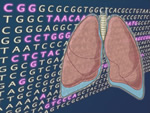 A consortium that includes scientists from the National Human Genome Research Institute has identified a gene associated with an increased susceptibility for lung cancer in members of families with a history of the disease. The new finding is reported in the April 15, 2009 issue of the journal Clinical Cancer Research.
A consortium that includes scientists from the National Human Genome Research Institute has identified a gene associated with an increased susceptibility for lung cancer in members of families with a history of the disease. The new finding is reported in the April 15, 2009 issue of the journal Clinical Cancer Research. -
March 2009: NHGRI Research Helps to Demystify Dyslexia
 Dyslexia is one of the world's most common learning disorders. NHGRI researchers are helping to open a new window on this complex condition with a new genomic discovery reported in the journal PLoS Genetics.
Dyslexia is one of the world's most common learning disorders. NHGRI researchers are helping to open a new window on this complex condition with a new genomic discovery reported in the journal PLoS Genetics. -
January 2009: Darwin @200
 February 12, 2009, marks the 200th birthday of Charles Darwin (1809-1882) and the 150th year since publication of his seminal work, On the Origin of Species. The National Human Genome Research Institute will observe Darwin's life and accomplishments at events at the NIH's Bethesda campus and at the Smithsonian Institution's National Museum of Natural History.
February 12, 2009, marks the 200th birthday of Charles Darwin (1809-1882) and the 150th year since publication of his seminal work, On the Origin of Species. The National Human Genome Research Institute will observe Darwin's life and accomplishments at events at the NIH's Bethesda campus and at the Smithsonian Institution's National Museum of Natural History.
2008
-
December 2008: Two NHGRI Intramural Investigators Selected for Presidential Award
 Two National Human Genome Research Institute (NHGRI) investigators - cancer geneticist Daphne W. Bell, Ph.D., investigator in the Cancer Genetics Branch, and bioinformatician Elliott Margulies, Ph.D., investigator in the Genome Technology Branch - have received the 2007 Presidential Early Career Award for Scientists and Engineers (PECASE). They are among 12 PECASE awardees supported by the National Institutes of Health (NIH) and the only NIH intramural investigators among this year's awardees. The awards were presented at a White House ceremony on Dec. 19, 2008.
Two National Human Genome Research Institute (NHGRI) investigators - cancer geneticist Daphne W. Bell, Ph.D., investigator in the Cancer Genetics Branch, and bioinformatician Elliott Margulies, Ph.D., investigator in the Genome Technology Branch - have received the 2007 Presidential Early Career Award for Scientists and Engineers (PECASE). They are among 12 PECASE awardees supported by the National Institutes of Health (NIH) and the only NIH intramural investigators among this year's awardees. The awards were presented at a White House ceremony on Dec. 19, 2008. -
November 2008: Chemical Genomics Screen Uncovers Clues to Fat Storage
 In a study published in the Nov. 25, 2008 issue of PLoS Biology, a team from the National Institute of Diabetes and Digestive and Kidney Diseases, the University of Maryland, Baltimore, and the NIH Chemical Genomics Center - an affiliated center with NHGRI - identified a cellular pathway that regulates fat storage and showed that interrupting the pathway boosts the amount of fat stored by human cells.
In a study published in the Nov. 25, 2008 issue of PLoS Biology, a team from the National Institute of Diabetes and Digestive and Kidney Diseases, the University of Maryland, Baltimore, and the NIH Chemical Genomics Center - an affiliated center with NHGRI - identified a cellular pathway that regulates fat storage and showed that interrupting the pathway boosts the amount of fat stored by human cells. -
May 2008: NHGRI Research Reveals Humans Share a Common Set of Skin Microbes
 A team of researchers from the National Institutes of Health (NIH), led by Julie Segre, Ph.D., a senior investigator in the Genetics and Molecular Biology Branch at the National Human Genome Research Institute (NHGRI), has found that healthy humans share a common set of microorganisms living in and on the area of skin around the inner elbow, an area where atopic dermatitis (eczema) is known to develop, research published a study in the online issue of Genome Research.
A team of researchers from the National Institutes of Health (NIH), led by Julie Segre, Ph.D., a senior investigator in the Genetics and Molecular Biology Branch at the National Human Genome Research Institute (NHGRI), has found that healthy humans share a common set of microorganisms living in and on the area of skin around the inner elbow, an area where atopic dermatitis (eczema) is known to develop, research published a study in the online issue of Genome Research. -
April 2008: Dr. Pamela Schwartzberg Inducted into Association of American Physicions
 Pamela Schwartzberg, M.D., Ph.D., senior investigator in the Genetic Disease Research Branch, is a 2008 inductee into the Association of American Physicians (AAP). She was inducted at the AAP's annual meeting in Chicago, April 25-27, 2008.
Pamela Schwartzberg, M.D., Ph.D., senior investigator in the Genetic Disease Research Branch, is a 2008 inductee into the Association of American Physicians (AAP). She was inducted at the AAP's annual meeting in Chicago, April 25-27, 2008. -
February 2008: Finding What's Toxic Fast
 Chemical compounds - from household cleaners to pesticides - require testing to reveal hazards that they may pose to human health. An effort now underway by three collaborating federal research groups seeks to rapidly evaluate larger numbers of chemicals for risks to humans while reducing the role of laboratory animals in regulatory testing.
Chemical compounds - from household cleaners to pesticides - require testing to reveal hazards that they may pose to human health. An effort now underway by three collaborating federal research groups seeks to rapidly evaluate larger numbers of chemicals for risks to humans while reducing the role of laboratory animals in regulatory testing. -
January 2008: Pam Schwartzberg Wins AAI Investigator Award
 Pamela L. Schwartzberg, M.D., Ph.D., senior investigator and head of the Cell Signaling Section of the Genetic Disease Research Branch of the National Human Genome Research Institute (NHGRI), will receive the AAI-BD Biosciences Investigator Award from the American Association of Immunologists (AAI).
Pamela L. Schwartzberg, M.D., Ph.D., senior investigator and head of the Cell Signaling Section of the Genetic Disease Research Branch of the National Human Genome Research Institute (NHGRI), will receive the AAI-BD Biosciences Investigator Award from the American Association of Immunologists (AAI).
Last Updated: March 8, 2019


